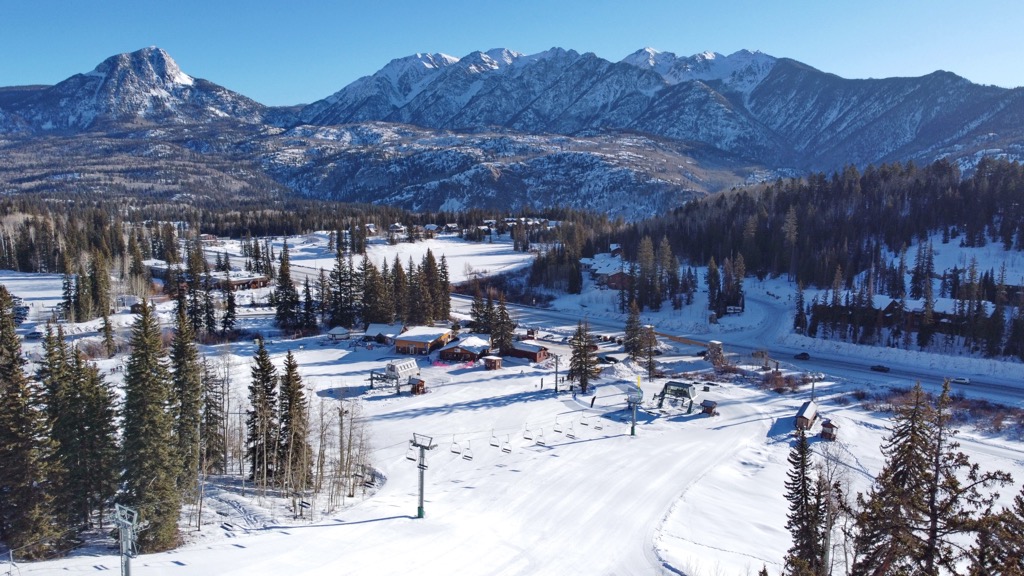Get PeakVisor App
Sign In
Search by GPS coordinates
- Latitude
- ° ' ''
- Longitude
- ° ' ''
- Units of Length
- Temperature

Yes
Cancel
Share ×

Scan the QR code and open PeakVisor on your phone
❤ Wishlist ×
Choose
Delete
Telluride Ski Resort is one of 28 ski resorts in the Rocky Mountains of Colorado, USA. The resort is located in the San Juan Mountains near the Four Corners region, where the states of Colorado, New Mexico, Arizona, and Utah meet. Telluride has 148 individually named slopes and 19 ski lifts. The lift-access skiing tops out at over 12,500 ft (3,810 ft) while hike-to terrain access an additional 600 ft of vertical, topping out at over 13,000 ft (4,000 m). Most skiers consider Telluride an advanced ski mountain, but the resort caters well to beginners and advanced skiers. In contrast, intermediate skiers who cannot graduate to black slopes may find Telluride limited. The Telluride ski season is from Thanksgiving (late November) to early April, with closing day generally the first Sunday of April. The resort is not among the snowiest in the Western US, with about 250-280 inches (~6-7 meters) of annual snowfall. Nevertheless, Telluride’s high altitude and north aspect ensure that every one of these inches counts, and you can expect many powder days each season.
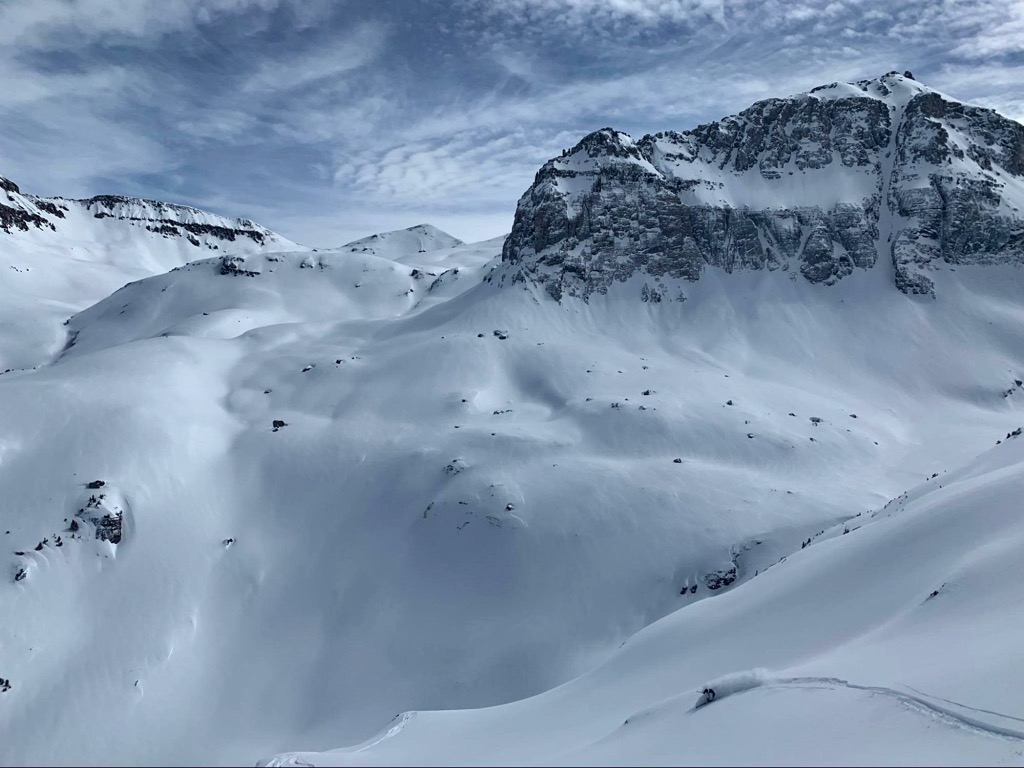
Telluride sits atop the northwestern corner of the San Juan Mountains of Colorado, “Colorado’s finest range,” as legendary mountaineer Gerry Roach likes to say. Telluride is just a few miles as the crow flies from Ridgway, Ouray, and Silverton, CO, although driving takes much longer due to winding roads through the mountains.
Telluride is ultra-remote in terms of the nearest major city, a notable factor in limiting crowds during the winter (the other being cost - more on that later). The town is about six hours by car from Denver, Colorado, Salt Lake City, Utah, and Albuquerque, New Mexico.
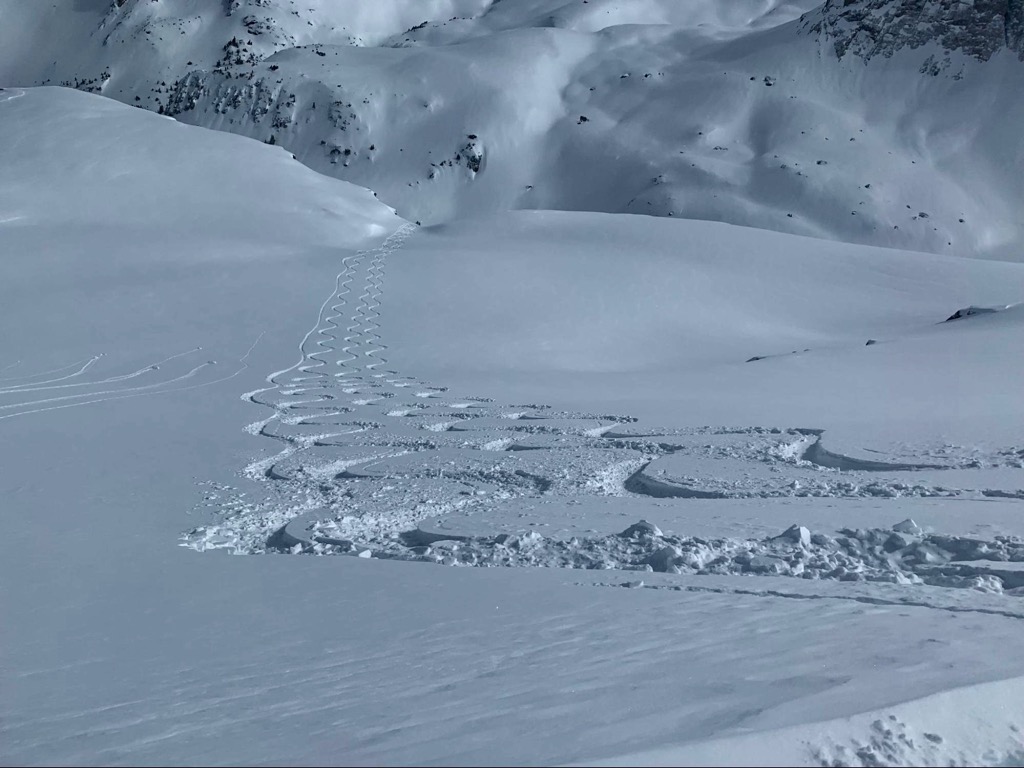
Getting to Telluride is trickier than most other Colorado resorts, hence the mountain's relative lack of skier traffic.
It’s a six-hour drive to Telluride from the nearest large cities. Be wary of winter weather on the way over. It’s essential to have, at a bare minimum, snow tires, even if you plan on staying on the highway. I-70 regularly turns into a parking lot, and tourists take a lot of wrath from locals for being unprepared to drive in the snow.
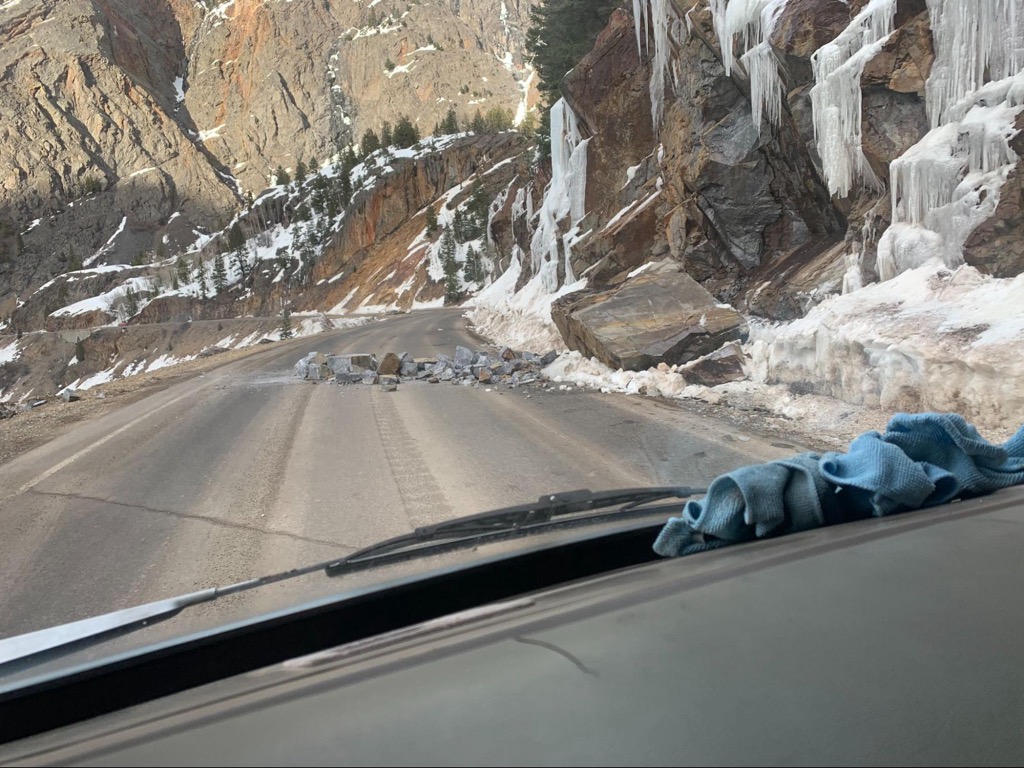
Check the CDOT Website for a full update on road conditions, complete with webcams. As I’ve mentioned, having snow tires is essential, but 4x4 or AWD, in addition, is ideal. If you only have 2WD, carry chains and know how to put them on.
Nevertheless, the roads are usually passable, and the drive is beautiful. I’ve always found it easy to drive all day in the Western US. For this reason, Telluride gets a lot of visitors who drive in from far out of town.

Most people flying to Telluride arrive via Montrose Airport, where they rent a car or get picked up by a shuttle (Mountain Limo and Telluride Express are the most popular). Although Montrose is a small airport, it’s easy to obtain a connection from anywhere in the U.S. because they have daily service from large airports like Dallas and Denver.
Flying into Telluride airport is also possible. For years, the airport was for private jets only, but has recently begun public service as well. Telluride
Check out the resort's webpage for details about your Montrose or Telluride flight.
Telluride Ski Resort aims to run its lifts from the American holiday of Thanksgiving (fourth Thursday of Nov.) until the first Sunday of April. Often, the resort can’t open for Thanksgiving; there simply isn’t enough snow or cold air to make it.
The season's first few weeks generally feature just a few open pistes on the lower mountain. Much of the mountain relies on natural snow, including all of the off-piste terrain. Most seasons see enough white stuff by Christmas to open the bulk of the resort. There are rarely issues with the closing day; most years, Telluride could stay open until May with their snow coverage. Unfortunately for locals, it’s just not economically viable.
Palmyra Peak reaches 13,113 ft (3,996 m), so winter sticks around Telluride long after the resort has closed. Silverton Mountain is a guided-only, lift-access backcountry resort that offers an unguided ‘season’ during April. Some of my best powder days in the San Juans have been in April, and it’s worth a visit if you’re a backcountry skier or rider.
Telluride is home to some of the lightest snow on Earth. The snow quality is, on average, even fluffier than the hallowed ground of Little Cottonwood Canyon, Utah (although they get far more snow than us).
Telluride is nestled deep in the American Southwest, almost one thousand miles (1,600 km) from the Pacific Ocean, which generates moisture for the storms that roll through Western North America.
Deserts surround Telluride; the red rock of Moab, Utah, is less than 100 miles (160 km) away as the crow flies. The dry climate and cold temperatures efficiently produce beautifully structured snow crystals called stellar dendrites. These flakes accumulate with lots of air between the long arms of the crystals’ lattice structure. The feeling of skiing through this type of ‘blower’ powder is closer to skiing through air than through the heavy snow that defines maritime climates like California.
The snow isn’t always super light. I’ve seen dumps of dense powder and even rain on the mountain, although this is exceedingly rare. Nevertheless, the snow falls as blower powder with a higher frequency than any other place I’ve been.
Better yet, the snow almost never gets icy here. That’s because the high-altitude desert air is so dry that it effectively sucks the moisture out of the snowpack. In the absence of new snowfall, you tend to get a cold, chalky layer rather than the hard, icy conditions that define other ski resorts.
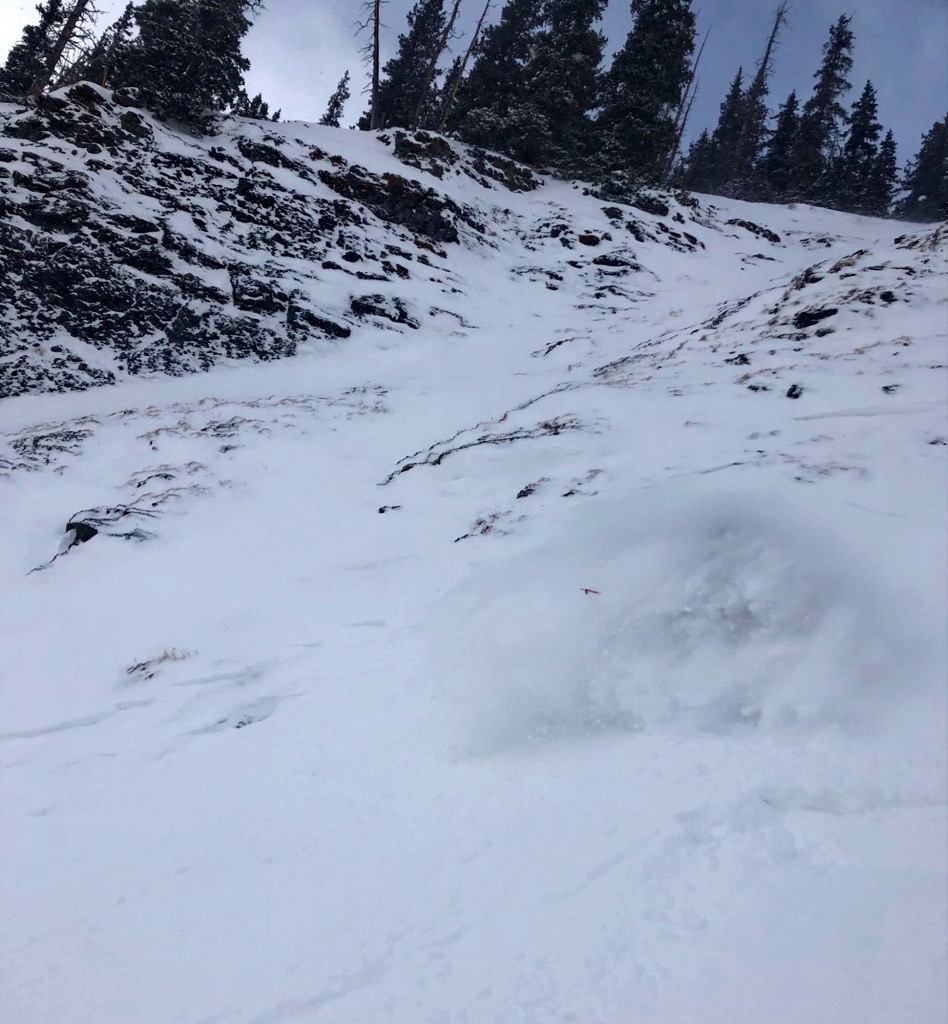
Powderhounds relish low-visibility storm days, and even the most fair-weather skiers must accept the fact that it has to snow to make skiing possible. But prospective Telluride visitors can take solace in the fact that the sun is shining when it’s not snowing.
Coming to Telluride on a one-week vacation, there’s a good chance you’ll get fresh snow and even a great powder day. But it’s virtually certain that you’ll have at least a few beautiful days to frolic in the sunshine.
Lots of sun means that bringing sunscreen, chapstick, and sunglasses is essential. Moreover, Telluride is high-altitude and far south at only 38° latitude, two additional factors that make the sun here more dangerous.
Telluride’s proximity to the desert is a double-edged sword. On the one hand, the snow quality is unrivaled. However, it is quality over quantity, as Telluride does not receive tremendous amounts of snow.
The resort will tell you they average over 300 inches per year, but it’s unlikely that’s the case. From my experience during six years in town and talking with many long-time locals, it seems reasonable to place the annual snowfall at around 250 inches. That’s about half of what famous resorts like Alta, Utah, and Palisades Tahoe, California receive. However, I assure you that the snow conditions are consistently better in Telluride than any other resort I’ve ever skied.
The mountain is primarily north and west-facing, so the sun doesn’t transform the powder too quickly; it can stay fluffy for days after a storm. Telluride’s geography tends to favor smaller storms that drop a little bit of snow each day. Locals will tell you that the best powder day is getting three inches a day for four days rather than 12 inches overnight.
While it’s impossible to predict the weather, certain times of the year tend to offer the best conditions.
December is a gamble for those looking to visit Telluride on vacation. Generally, the snow cover is relatively thin, and the skiing is limited to a few groomers, namely the See Forever trail, known to locals as the “super loop.”
The Christmas and New Year’s holidays are more snow-sure but also subject to extraordinarily inflated prices and crowds. If money is no object and you want to ski during Christmas, Telluride is perfect, but it’s not the best time to come from a conditions standpoint.
I will say, however, that it often snows here on Christmas. It snowed on Christmas almost every year while I lived in Telluride, which added a special touch to the holiday.

January is an excellent month to visit Telluride if you seek powder snow and low crowds. For sunny, warm laps on the groomers, I don’t recommend it; January can be cold, and the sun angle is low, so large swaths of the mountain are in the shade all day.
The low sun angle means that powder falling in January often stays soft for days at a time. The base is usually deep enough by this time to ski the trees and the more adventurous off-piste terrain on the upper mountain.
There are rarely crowds, and you and the locals share powder days. Accommodation is cheaper and easier to come by. Note that the U.S. holiday celebrating Martin Luther King (the third Monday of January) is the exception. It can get swamped during MLK weekend.
On the flip side, January can often be quite dry and clear, leading to the nickname “June-uary.” That said, I saw plenty of January storms during my time in Telluride.
February is a prime month to visit Telluride. There tends to be consistent snow, and the mountain still has the advantage of limited sun effect and cold temperatures to keep snow conditions soft. Moreover, the base is more reliable than January, and it’s almost sure that you’ll be able to experience some of Telluride's sublime tree skiing.
February and March are the busiest months of the season, so you won’t have as many of those days where it feels like you have the mountain to yourself. Still, Telluride is not particularly crowded to begin with, so most tourists won’t find it to be a big deal.
March is typically the best skiing in Telluride. The base is deep, the temperatures are warmer but still conducive to powder snow, the sun shines brilliantly across the whole mountain, and the atmosphere tends to bring more significant snowfalls than during the depths of winter. During high-pressure spells, the spring-like warmth that descends upon the slopes beginning mid-to-late March can create soft, slushy conditions, especially on the lower mountain. Best of all, the entire mountain is likely to be open, including the fabled hike-to terrain off from Palmyra Peak and the Gold Hill Chutes.
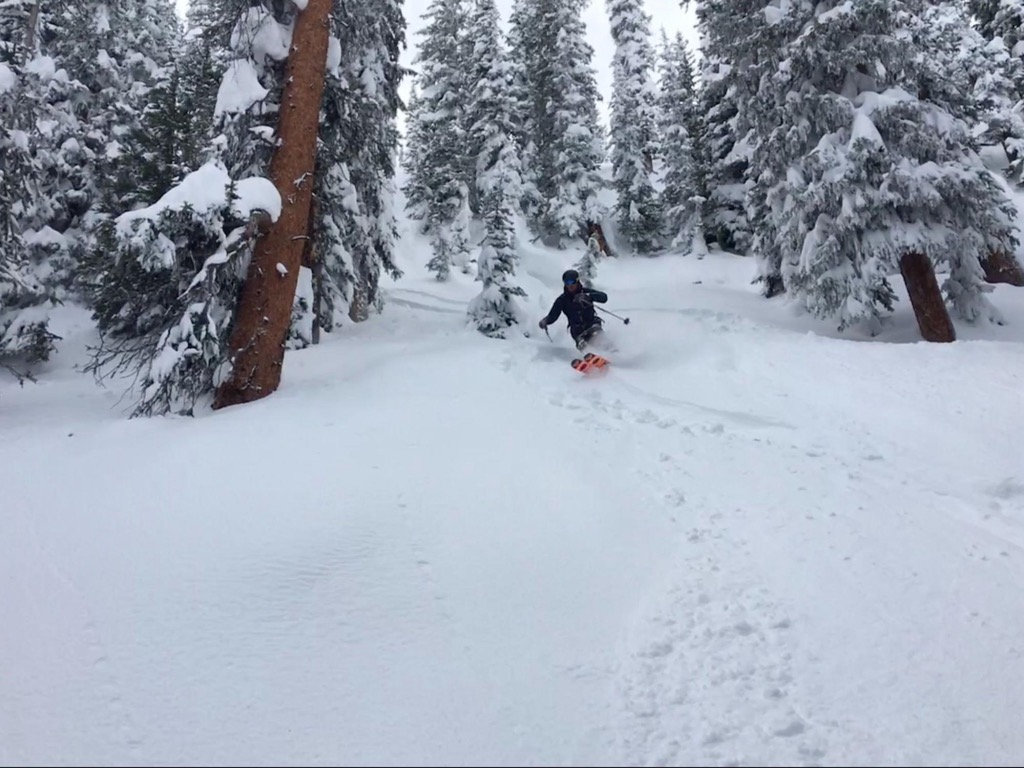
Moreover, for backcountry-minded skiers, the infamously fickle Colorado snowpack begins to consolidate during this time. The higher sun angle and warmer temperatures reduce the snowpack's temperature gradient, helping bond faceted layers. Check out PeakVisor’s Avalanche Guide for a more thorough introduction to snow science and avalanches.
On the other hand, as good as they can be, powder days in March get tracked out even faster than usual. Locals and tourists alike are on the slopes, taking advantage of fresh snow. Fortunately, there is also more terrain open to accommodate the extra traffic. Prepare to pay a premium for lodging in March; as is often the case in this small town, demand exceeds supply.
The resort’s last week or two is usually a locals’ springtime bonanza, as all the tourists have departed and the lower mountain begins to wilt in the spring sun. Some of Telluride’s most prized lift-access lines sometimes come into condition around this time, although not every year. The closing day usually features an incredible party at the base of the Coonskin lift (Chair 7).
Telluride is a tricky mountain to learn. Tourists can spend a few days just learning where all the different lifts and trails lead, while long-time locals can still explore pockets of terrain where they’ve never skied. The ski area has so many hidden zones that only a few old-timers have ever truly skied everything.
Like all North American resorts, Telluride’s website and mobile app provide a detailed map of the resort. These cartoon maps offer a comprehensive overview of the main trails and resort infrastructure, including lifts, restaurants, and - importantly - backcountry access points.
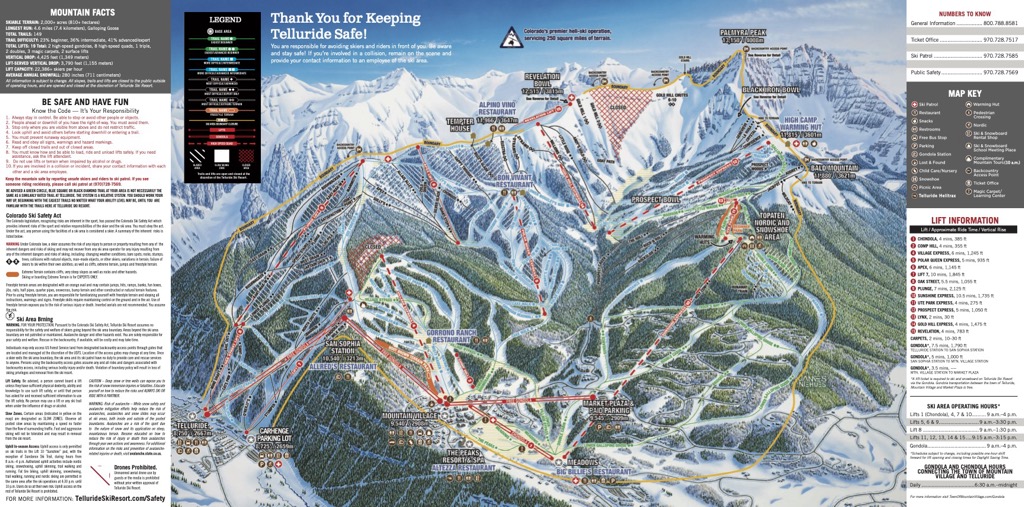
I also like how Telluride provides more detailed maps of its expert and extreme terrain in Prospect Bowl.
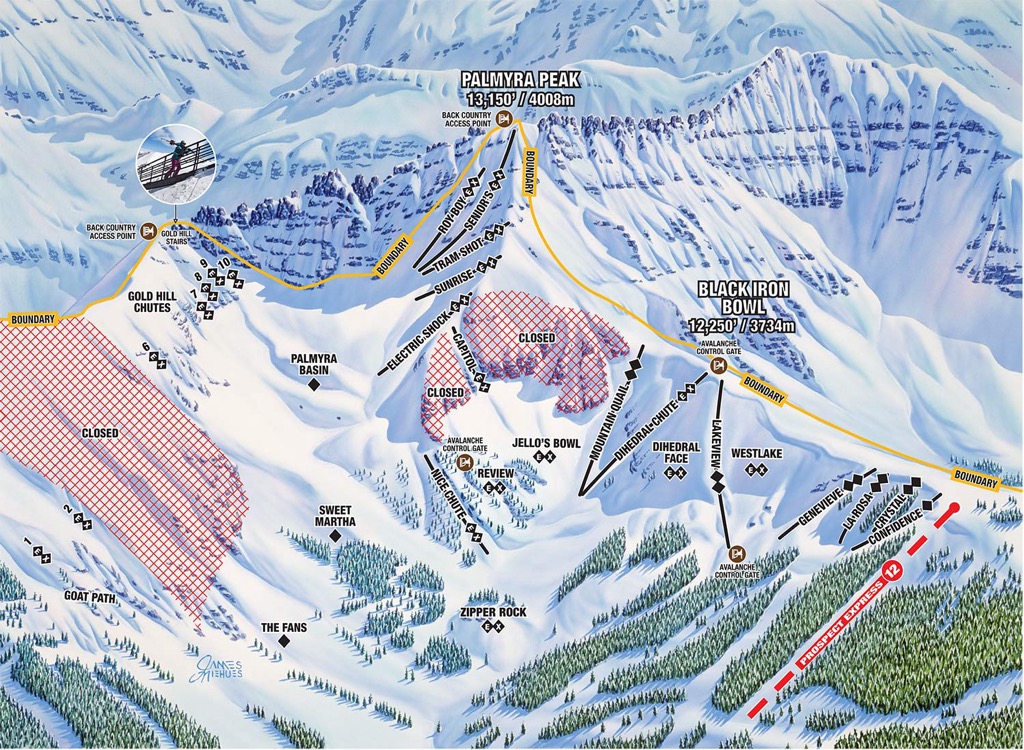
Best of all, Telluride is one of the few resorts I’ve seen that offers photo maps for the off-piste terrain. If you like skiing off-piste - which you probably do if you’re reading this article and considering Telluride - these maps will be your guide.
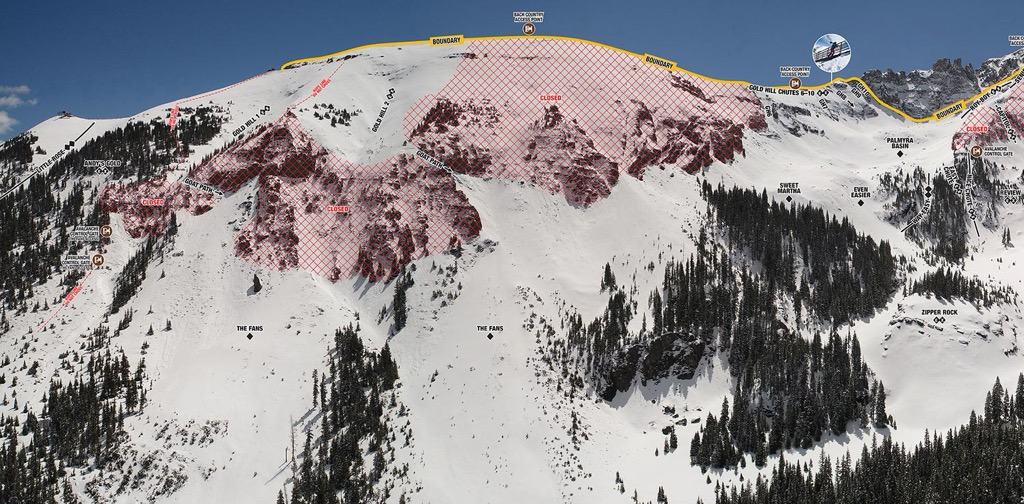
Another option is to use the PeakVisor mobile app, which offers a variety of advantages, especially for backcountry-minded skiers.
PeakVisor’s satellite imagery is far superior to a hand-drawn cartoon map and doesn’t embellish the snow coverage. Trails include technical information like average and maximum slope angle, and it’s easy to orient the aspect of different parts of the mountain. You can run tracking and see your current location on the map, as well as keep track of your stats for that day. Moreover, the app is ideal for the backcountry routes around Telluride, including Bear Creek.
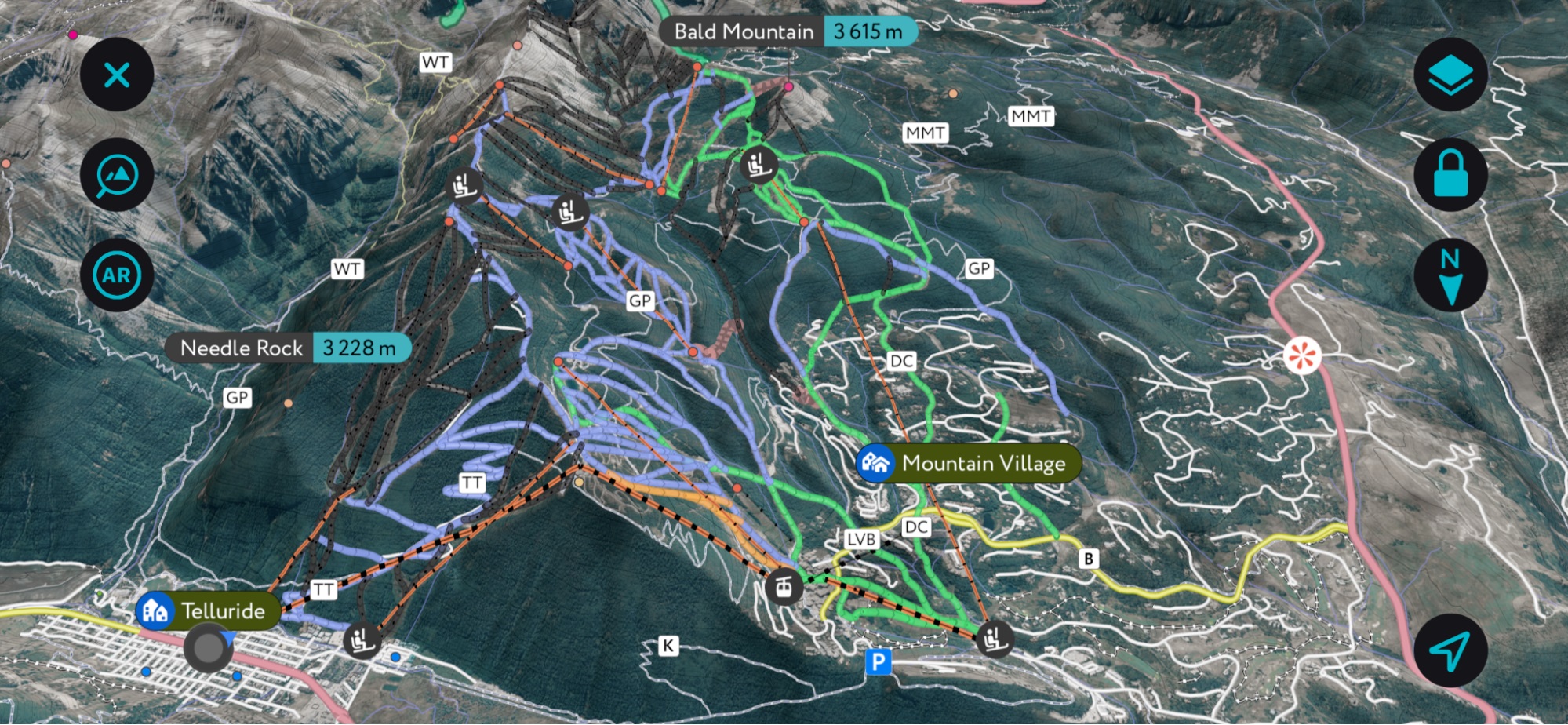
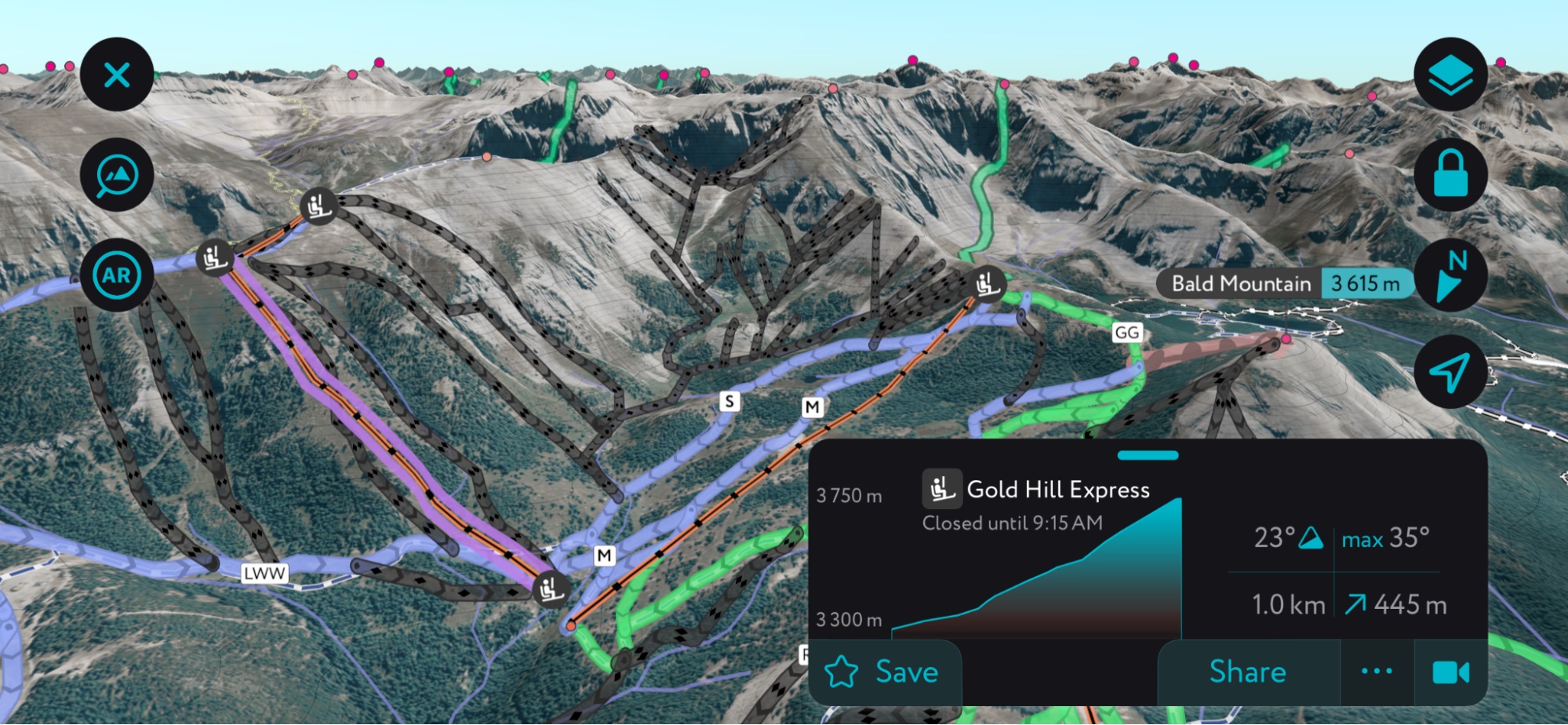
Telluride is home to 149 named trails spread across about 2000 skiable acres. Nineteen lifts serve a vertical drop of 3,845 ft (1,171 m) to two separate base areas: Telluride and Mountain Village. It’s possible to divide the mountain into several different zones, each of which I’ll discuss in detail below. You can ski any terrain at Telluride, but the hill best caters to advanced and expert off-piste skiers and, surprisingly, absolute beginners. As it turns out, Telluride is one of the best places to learn how to ski because of the abundance of easy, sun-drenched runs around the Mountain Village.
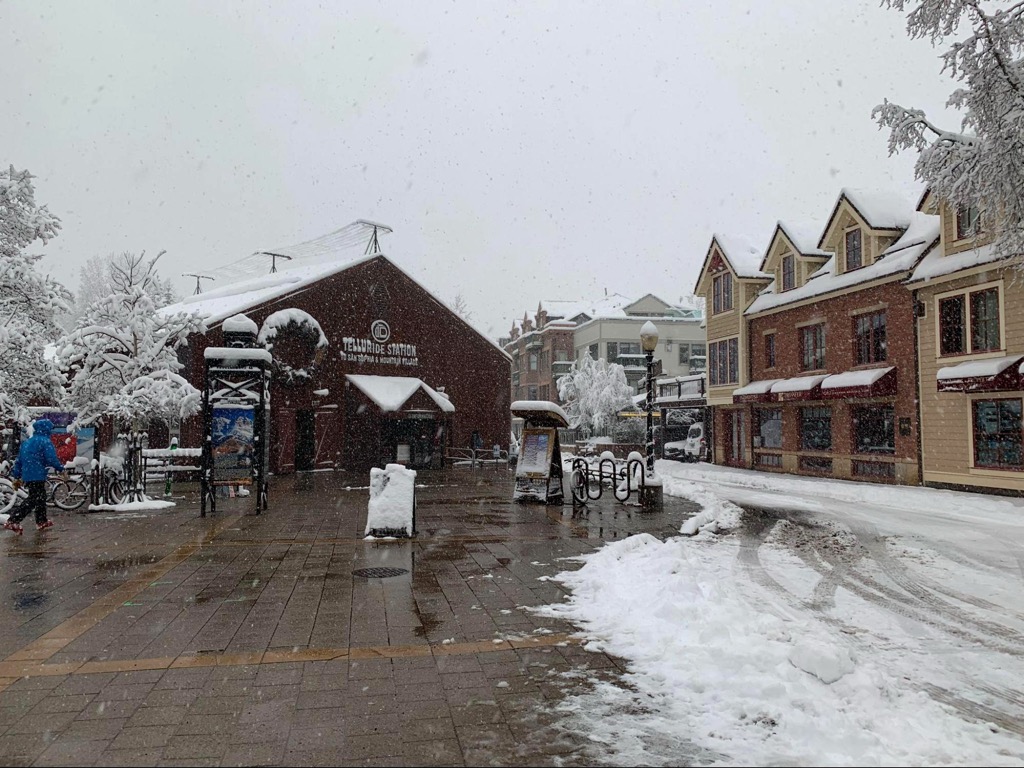
The lifts are often called by their numbers at Telluride. For example, locals call the Plunge lift “Chair 9.” I’ll reference both the number and name in this guide.
The Mountain Village Gondola connects the town of Telluride and Mountain Village and operates as both transportation and a ski lift. The Gondola is free, although you need a ski pass to disembark at the top with skis.
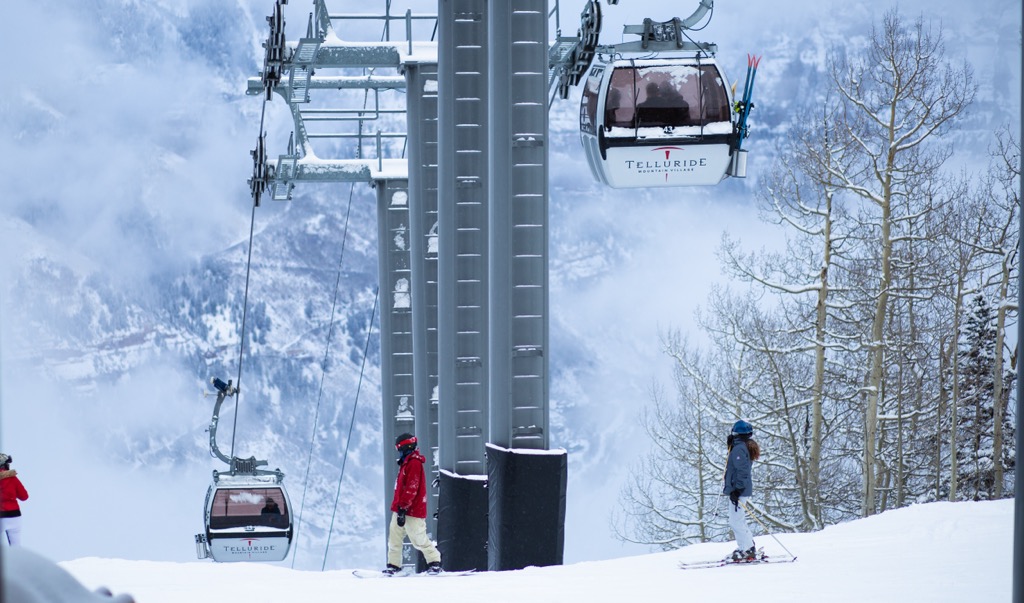
The Sunshine Express (Lift 10) is an excellent lift for beginners and intermediates looking for a warm-up. The slopes take quite a bit of sun and are low-angle. It’s a perfect place to learn how to ski. I practiced skiing backward here when there was nothing else to do. Locals call these slopes the “Real Estate Runs” because they track through all of the mansions that TelSki developed in the 90s.
A Chondola (Lift 1, colloquial for chairlift + gondola) also services a bunny slope for kids and beginners from the same area as Chair 10. You can also use the chondola to return to Chair 4 and the central Mountain Village plaza.
Some tree runs at the upper part of Chair 10, like “Holy Cow,” can be exciting for experts, but they are pretty short and not worth the long run out on easy slopes back to the base. Chair 10 also accesses Chair 11 and, eventually, the bottom of the Prospect Express lift.
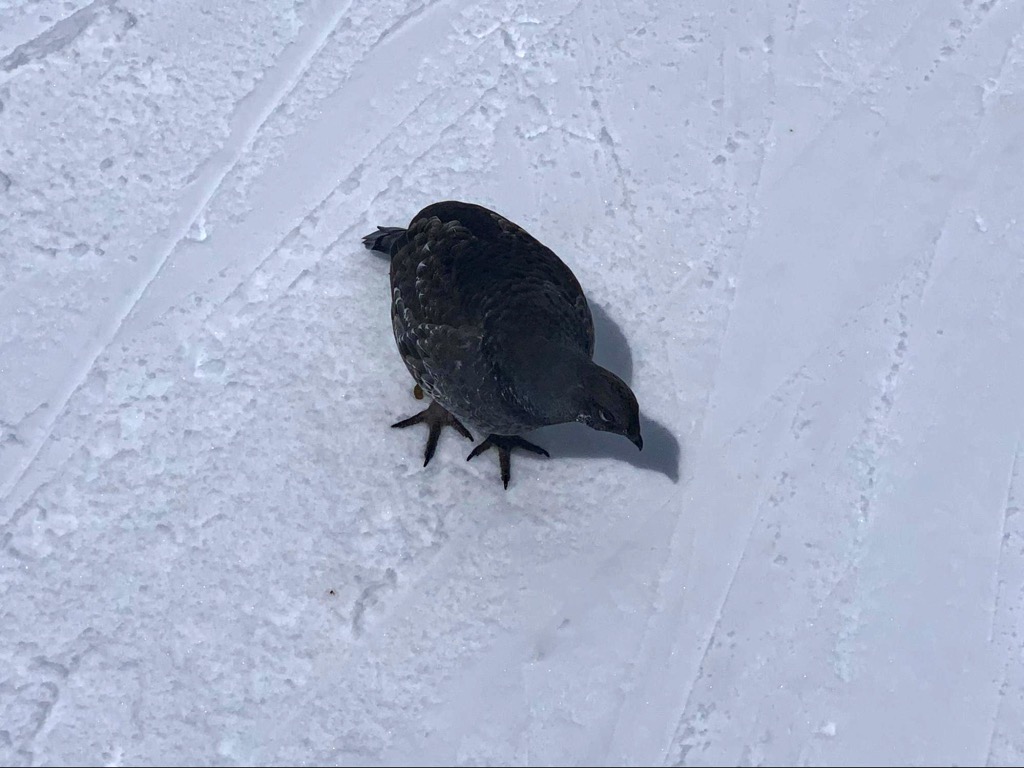
The original Telluride comprised Chairs 4,5, and 6. You could ski down to town, but you’d have to take a bus back to the Mountain Village, which, back then, consisted of a dirt parking lot.
The Mountain Village Express (Chair 4) is Telluride Ski Resort’s largest and most central base area. You can access any part of the mountain easily from here. It’s also a great zone to lap intermediate-level pistes. Goronno Ranch sits under the lift, while most of Mountain Village’s restaurants and shops are a short walk from the base.
Chair 4’s intermediate groomers are steep enough for anybody to enjoy carving down. However, be sure to control your speed here, as these are some of the most heavily trafficked slopes on the mountain.
Watch out for drunk skiers coming down from Goronno’s at the end of the day, and if you plan on drinking, be aware that you have to ski down afterward. Skiers getting inebriated at Goronno’s is an issue that the Ski Patrol takes very seriously, so you should be aware that there will be consequences should you have an accident or collision.
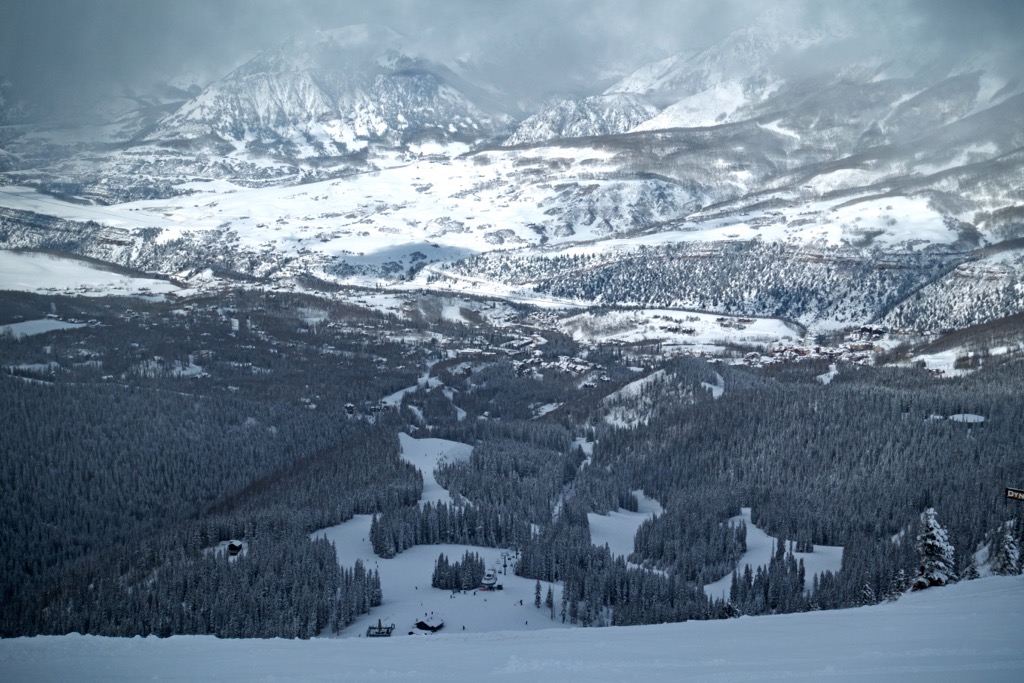
After Chair 4, many skiers will take Chair 5 and 6. Chair 5, the Polar Queen Express, offers similar terrain to Chair 4, including some intermediate off-piste sections perfect for wetting the feet. The trail “Henry’s” always features great moguls and is probably the best slope on the mountain if you’re learning how to ski bumps.
Chair 6 is almost exclusively expert off-piste terrain. You’ve got some excellent tree skiing flanking Allais Alley and a rare, south-facing slope with Sully’s. During the heart of winter, Sully’s is often crusty but can be incredible in the spring. Chair 6 also accesses See Forever, Colorado’s longest ski run. It’s a blue groomer all the way to the Chair 4 base.

After the resort’s first dozen or so years, the 1980s began seeing Telluride's expansion. The first significant expansion focused on the steep slopes above the old town of Telluride. This terrain was nicknamed the Dark Side because it received little sun during the heart of winter due to its steep north aspect.
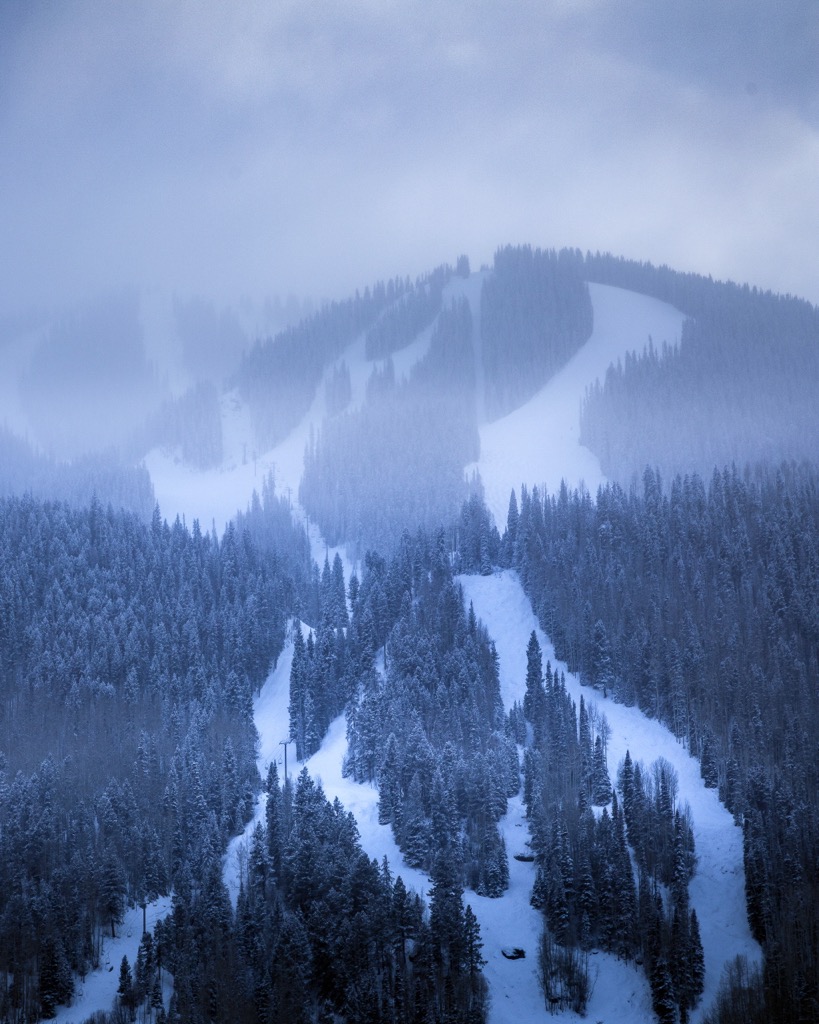
Telluride was a very different place back then than it is now. Coal and wood-burning stoves created so much smoke and soot that the town would be shrouded in fog on cold winter mornings when colder air settled in a valley inversion. Most of the Victorian cottages along the town’s few streets remained unrenovated. However, change was in the air. While some mining families still lived in town in 1980, most had departed by the decade's end.

The 80s saw the construction of three chairlifts: 7, 8, and 9 (the Coonskin, Oak Street, and Plunge chairlifts, respectively). The development significantly increased Telluride’s access and value as a destination. You could now live in towns and walk straight to the lifts. The terrain was steep, north-facing, and mostly ungroomed. While snowmaking now exists along some pistes off from Chair 7, the Plunge still features all-natural snow.

Chair 7 features some of the best-advanced groomers on the mountain, while Chair 8 primarily serves as an access lift to Chair 9. The off-piste here also has potential, but there is often insufficient snow cover for the skiing to be good. Chair 7’s pistes can be icy in the middle of winter but come into their own in spring when the sun softens “Milk Run,” and it becomes the best run on the mountain.
The crown jewel of the Dark Side is indisputably Chair 9. The Plunge lift offers up a spectacular array of slopes over its 2,200 feet (670 m) of vertical. A steep pitch dominates the terrain accessible from the lift. There are gladed tree lines, groomers, and lots and lots of mogul fields. Chair 9 also accesses my favorite groomers: Bushwacker, The Plunge, and Lookout. The lift was once a 14-minute-long relic where locals would throw back beers, smoke entire joints, watch other skiers from the lift, form connections with other human beings, and rest their legs from relentless moguls. For better or worse, the old chair has been replaced with a high-speed quad.
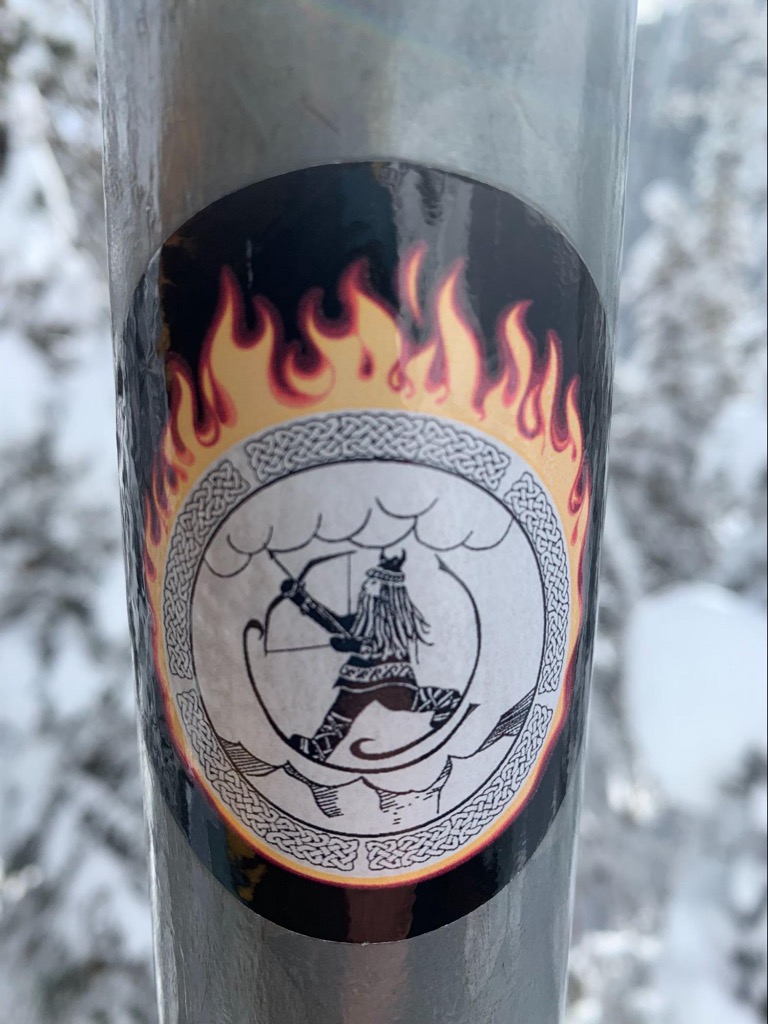
Chair 9 is undoubtedly one of the world’s finest destinations for moguls. The run directly under the lift, Kant-Mak-Em, is a patchwork of Volkswagon beetle-sized humps and troughs. It may seem like a nightmare to intermediate skiers, but this lattice-work of mounds is carefully sculpted each season, day after day, to reflect the perfect turns of die-hard local Telluride bump skiers. When you add a few inches of powder to the mix, these moguls flow like water. Seeing a seasoned Telluride mogul skier under the chair is like a Galton board, where a marble bounces down the pegs.
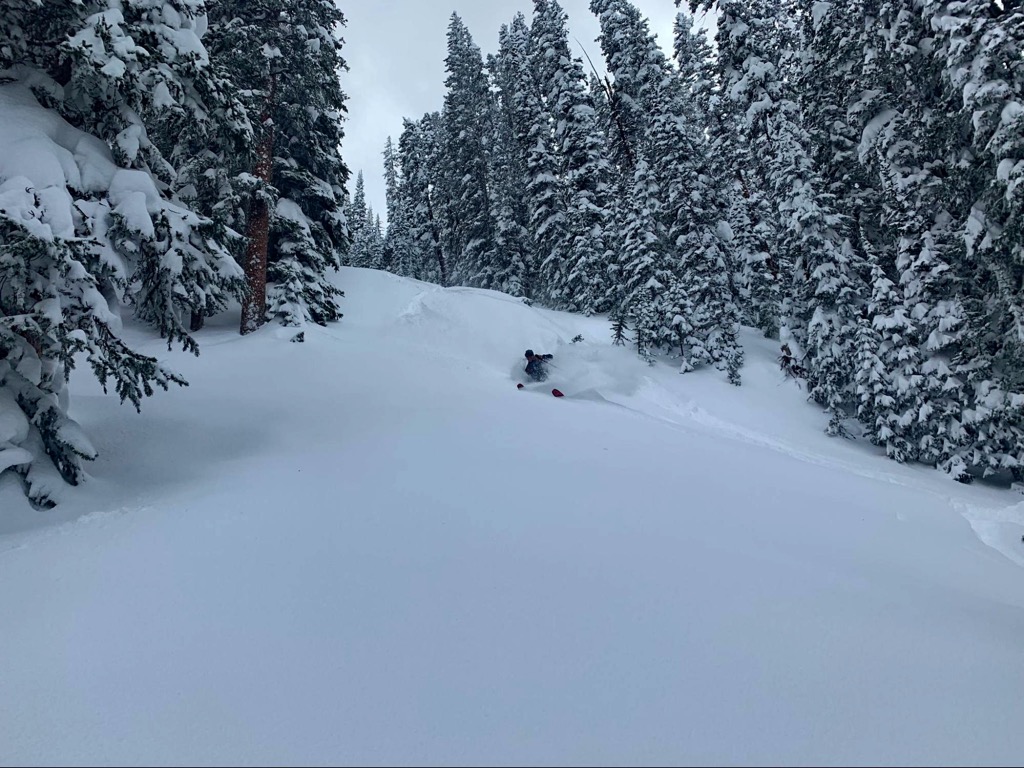
After the 1980s, the resort’s next significant expansion involved the terrain around Gold Hill and Prospect Bowl. Chairs 14, 15, and 12 (Gold Hill, Revelation Bowl, and Prospect, Respectively) opened up a new chapter in the annals of Telluride. Before the construction, this terrain was still accessible to those willing to hike. Some would argue that those were the glory days; they claim that it was better to ski a few laps in perfect conditions than to be able to ski six laps an hour through moguls.
Either way, the new lifts opened up a plethora of advanced off-piste terrain that really put Telluride on the map. The Gold Hill Express is one of the best chairs in the world during a storm day. Nowhere else can you find a high-speed lift with access to so many different lines. Alpine faces, well-spaced forests, pointer chutes, and couloirs abound. When the snow is soft, there’s nowhere I’d rather be than spinning laps on Chair 14.
The Gold Hill Express was built circa 2002 and opened up access to the Revelation Bowl, cutting the approach in half from Chair 6. A decade or so later, the resort followed suit with the Revelation Lift (Chair 15). The new lift made Revy Bowl lappable, a lovely addition to the resort. For locals, a bit of nostalgia came with seeing Revy Bowl fill with tracks within five minutes of opening. What was once a permanent powder stash was now permanently moguls.
Nevertheless, Chair 15 brought lift access up to 12,500 ft (3,810 m), making the Gold Hill Chutes and a few backcountry access gates much easier to reach. This continued to increase the extreme factor of Telluride; the Gold Hill chutes offer true couloir skiing, while the backcountry gates offer access to some of America’s most legendary slackcountry terrain.
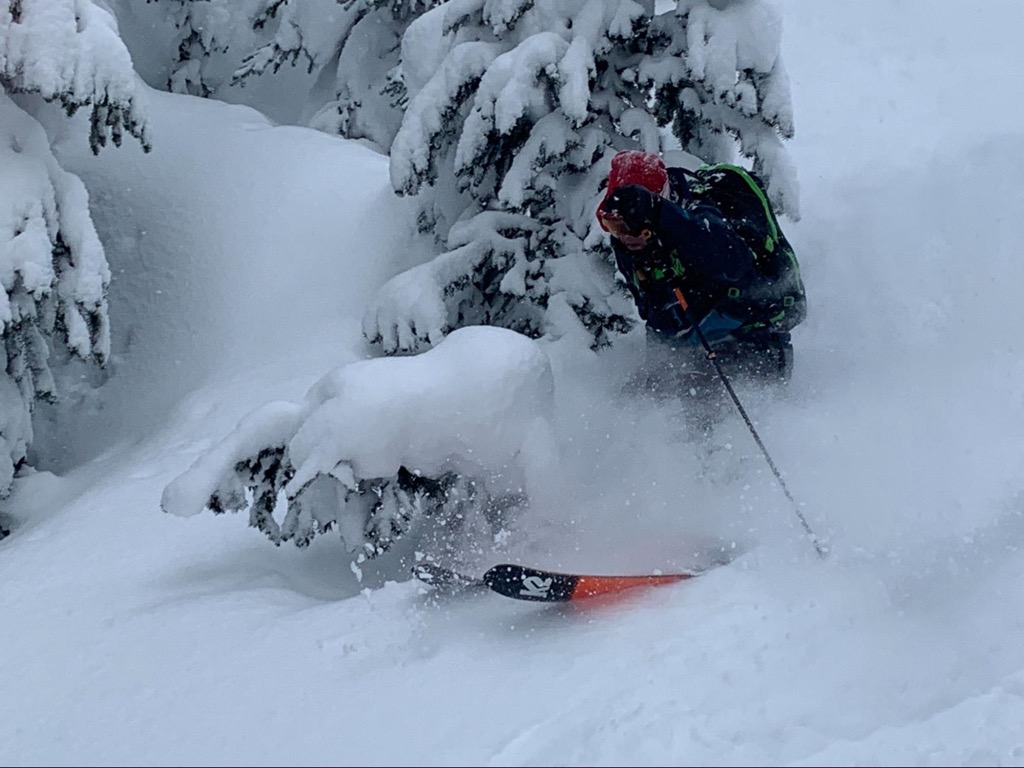
The Prospect Express (Chair 12) is of a similar vintage as Chair 14. The bottom of the Prospect Express is just a stone’s throw from the bottom of Chair 14, but the two lifts offer access to entirely different parts of the mountain.
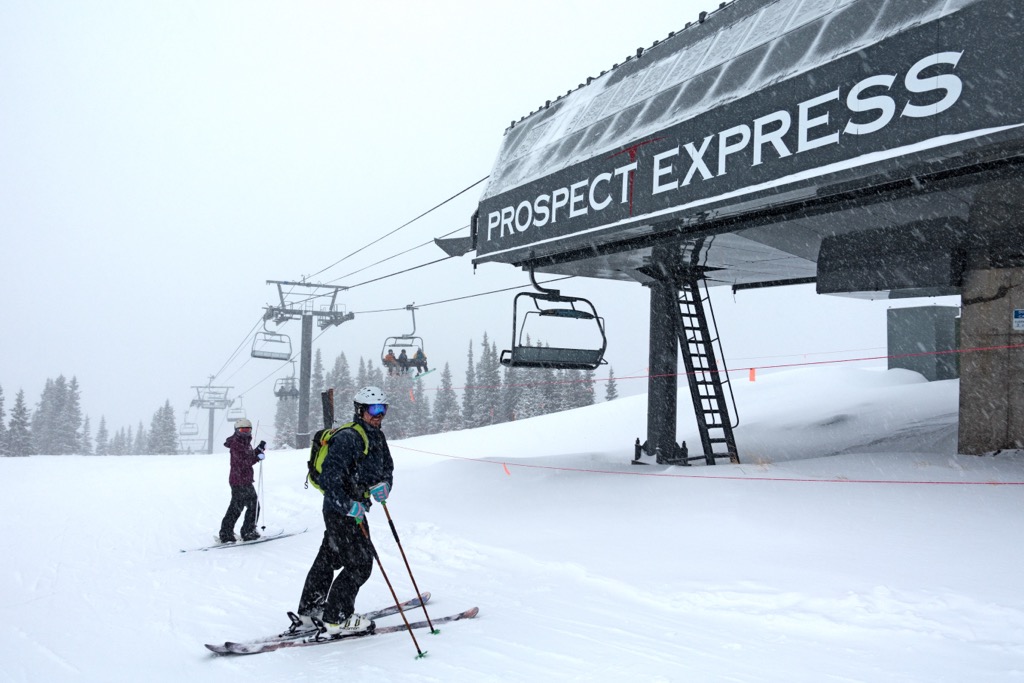
Chair 12 brings skiers to the shoulder of Palmyra Peak, with access to both easy and intermediate groomers, as well as serious, short but steep hike-to options along the ridge.
[INSERT “PROSPECT MOVIE” HERE]
As far as I can tell, Palmyra Peak is unique among U.S. ski resorts. The fact that it’s inbounds is incredible. With 45°+ slopes and legitimate couloirs, Palmyra Peak is only for expert skiers. The hike will filter out those not serious about committing to the terrain; it takes most folks an hour and a half of bootpacking along a steep ridgeline where a fall could be severe. It’s about 1,000 vertical feet (300 m) of ascent, although it feels like more at such a high altitude.
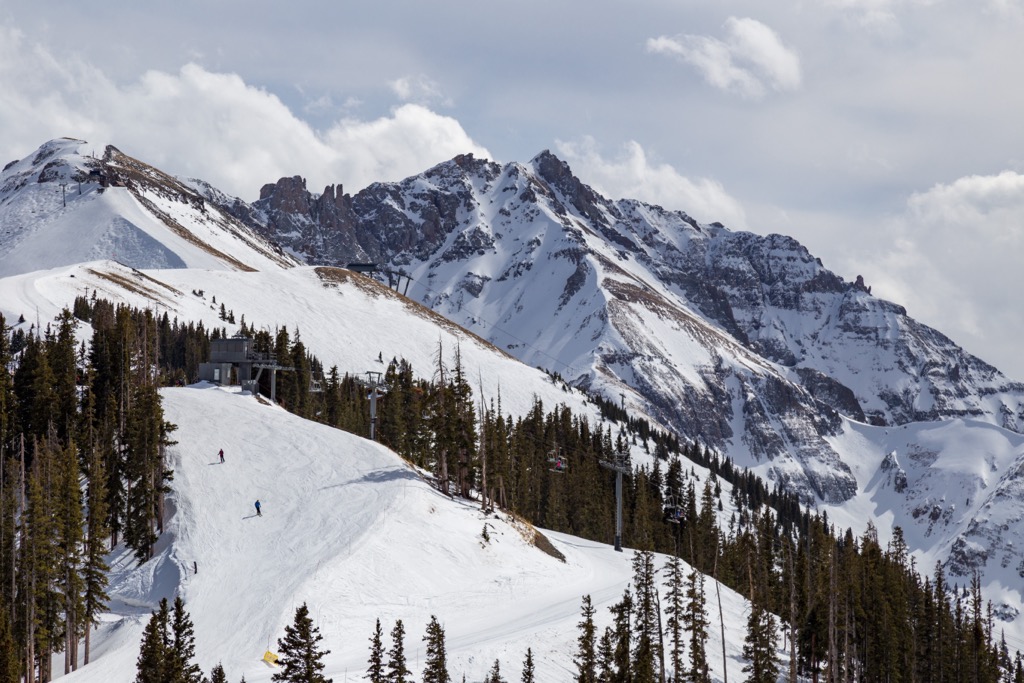
The summit is a mixture of endorphins from the exhausting hike up and excitement for the ski down. Descending Palmyra is an exercise in genuine steep skiing. The slope angle makes Kant-Mak-Em seem like a sledding hill. In hard conditions, jump turns are helpful. Even so, in powder, it skis like a dream.
Palmyra is only open later in the season, usually for about six weeks in February and March. It’s not open every day; if there’s a storm or even a lousy visibility day, Patrol will often close the peak, and it takes a couple of days after a storm for them to perform the complex avalanche control required for this terrain. If the Peak is open during your trip, take a couple of hours to do it. The hike and descent embody the physical and mental challenge that defines the legend of Telluride.
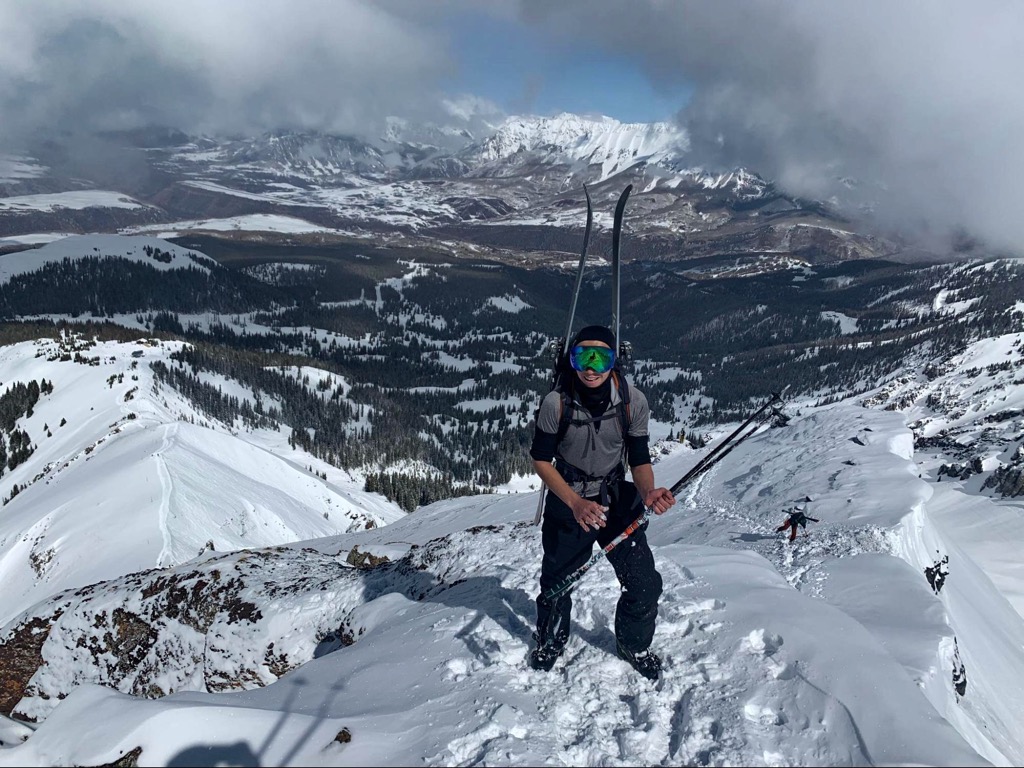
As legendary as Telluride Ski Resort is, many skiers would say that the backcountry terrain makes Telluride genuinely world-class. It’s critical to note that an avalanche course is recommended before skiing in the San Juan backcountry. The snowpack here is one of the world’s sketchiest, and dozens of people died around Telluride during the six years that I lived there.
Bear Creek refers to the drainage system adjacent to the Telluride Ski Resort. The Creek is a designated preserve, meaning it’s completely undeveloped save for a few hiking trails and an old road that is now only used for hiking. Mines used to operate here, but ruins are all that remain.
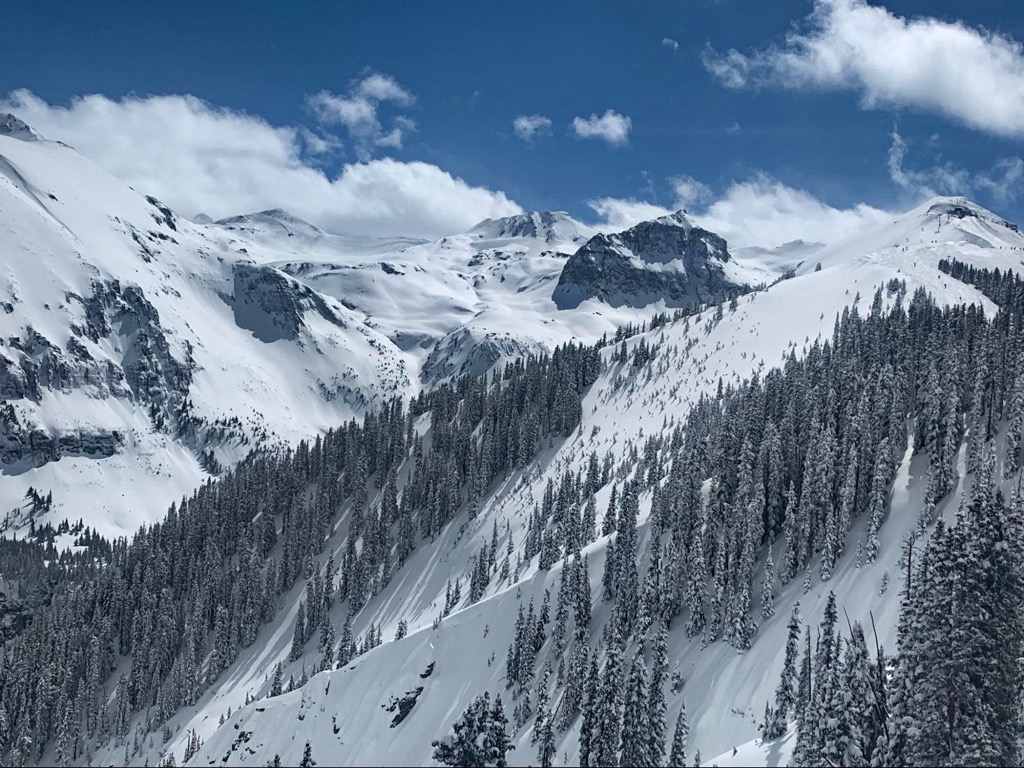
The Creek is hallowed ground in the niche world of backcountry powder skiing. Telluride Ski Resort shares a boundary with this zone from the top of Chair 9 up to Palmyra Peak. The west side of the ridge comprises the ski resort, while everything on the east side is Bear Creek. An entire world of skiing extends behind the ropes that demarcate the ski resort. Some of my most profound moments on skis have taken place back here.
Skiers often divide Bear Creek into two sections: Uppers and Lowers. The Uppers refer to the terrain behind Revelation Bowl and Gold Hill, mainly in the alpine. Meanwhile, the Lowers are defined by ancient forests. The resort features five backcountry gates designed to funnel skiers into this terrain, although people often duck the rope in other spots (not condoning this).
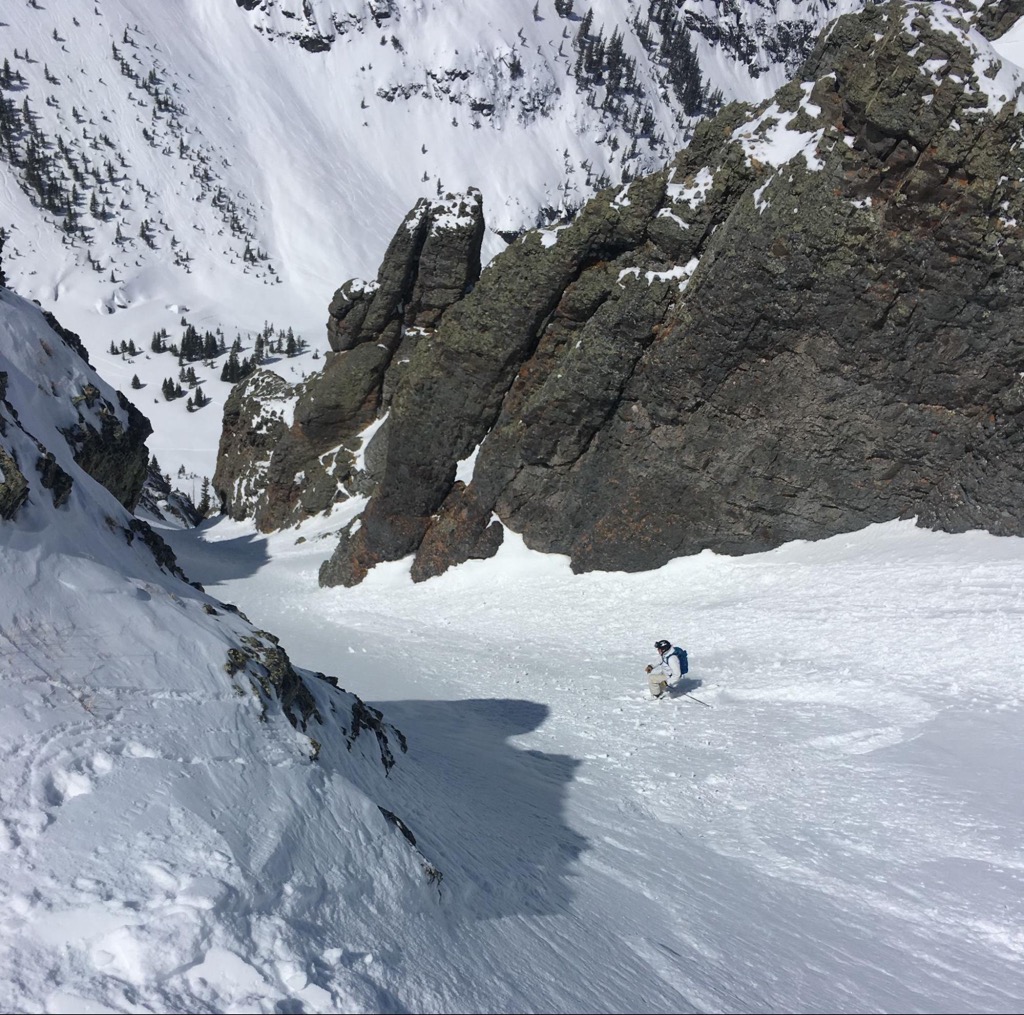
The Creek is a dangerous place. There are a few reasons why I think it’s even more hazardous than a pure backcountry zone. First, the lift access allows you to ski terrain without having first skinned up, which often results in ignorance about avy conditions. Secondly, while the skiing is challenging, the route-finding and avalanche situations are even more complex. You could be perfectly capable of just skiing the terrain back here, but to safely descend, you need mountain sense.
Another critical safety hazard in the Creek is the sheer number of skiers above you at any given time. Try not to ski on top of others, and be aware that there are likely very inexperienced people skiing back here who may unwittingly ski on top of you.
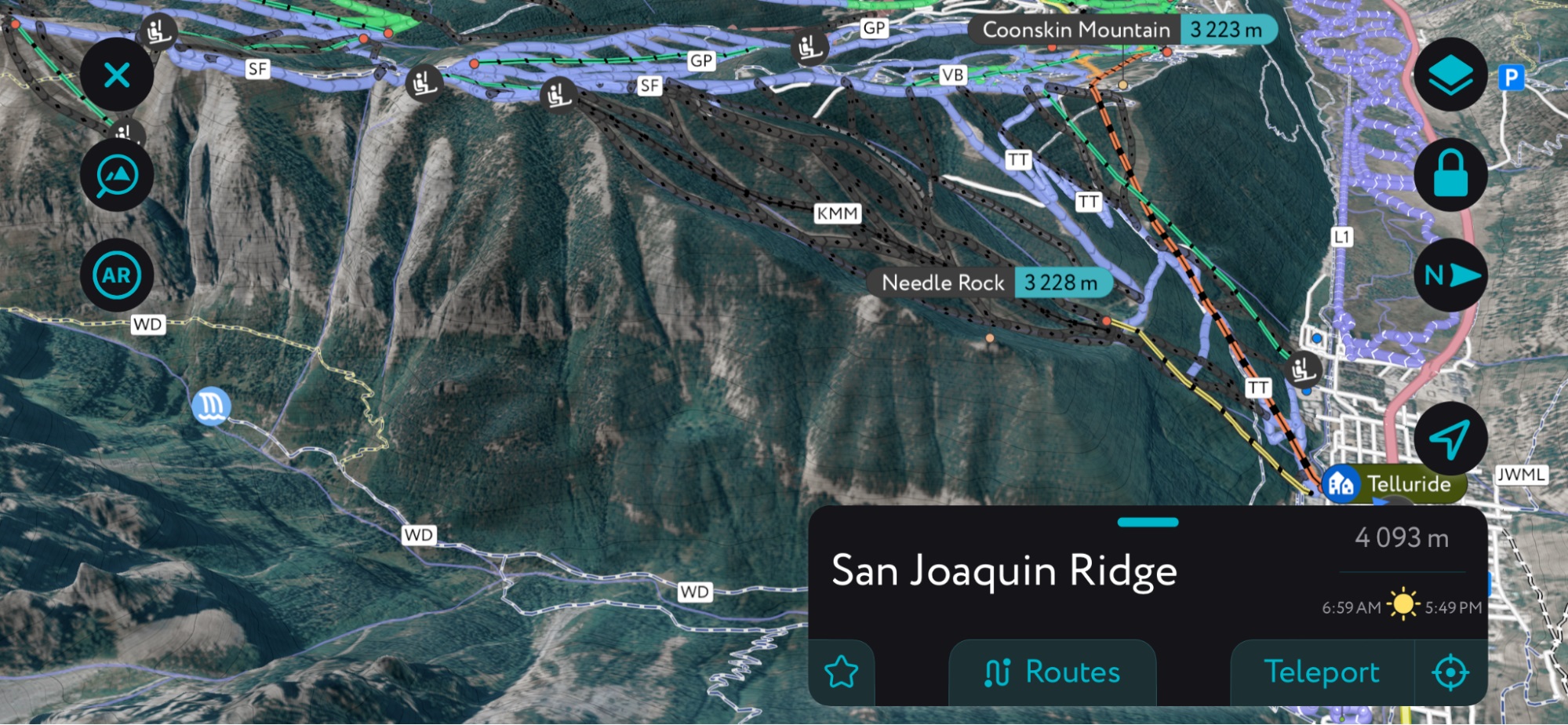
My advice to those looking to start exploring the creek is to find a safe, knowledgeable partner and don’t start skiing back there until you feel very comfortable ski touring in the backcountry; that means putting in 3000 ft days (900 m) on skins and safely navigating in the mountains.
In the Bible, Ophir is the name of a mythical kingdom reputed to be rich in gold. Miners first struck gold in Ophir, Colorado, in 1875, after which the town sprung up. The boom petered out by the early 1900s, and only a single resident remained by 1970.
Ophir’s second life paralleled the rise of Telluride Ski Resort, as the town is only 25 minutes away. Today, Ophir has a reputation as an even more hardcore ski vibe than T-town, primarily due to the access to backcountry skiing. Classic ski lines are peppered throughout the tight valley. Access involves parking your car and walking for 30 seconds into the forest.
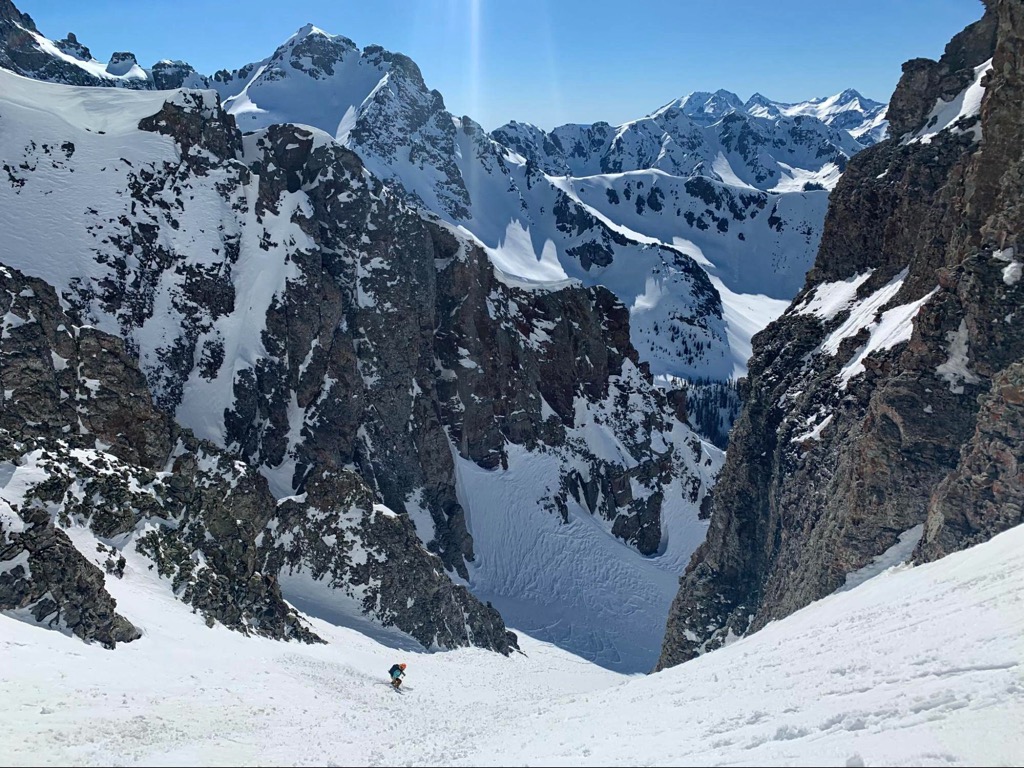
On the south side of the valley, Waterfall Canyon and Swamp Canyon are the two largest and most popular zones and are the most accessible from the town of Ophir. However, Trout Lake is the best access for the chutes at the back of Waterfall Canyon. The valley’s north side is a series of south-facing avalanche paths that offer board and open descents. Several decades ago, one of these paths took out most of the town, dividing the two remaining sections into East and West Ophir. Skiing from Telluride Ski Resort to Ophir is the most classic way to get one of these lines in condition while saving some puff.
Ophir is defined by its die-hard ski community, many of whom would be disappointed to see an article on the internet mentioning their fabled ski grounds. Nevertheless, Ophir caters to visitors through the famous Opus Hut, which sits near the top of Ophir Pass. You can also hire a guide through regional guiding outfitters like Mountain Trip or San Juan Mountain Guides.
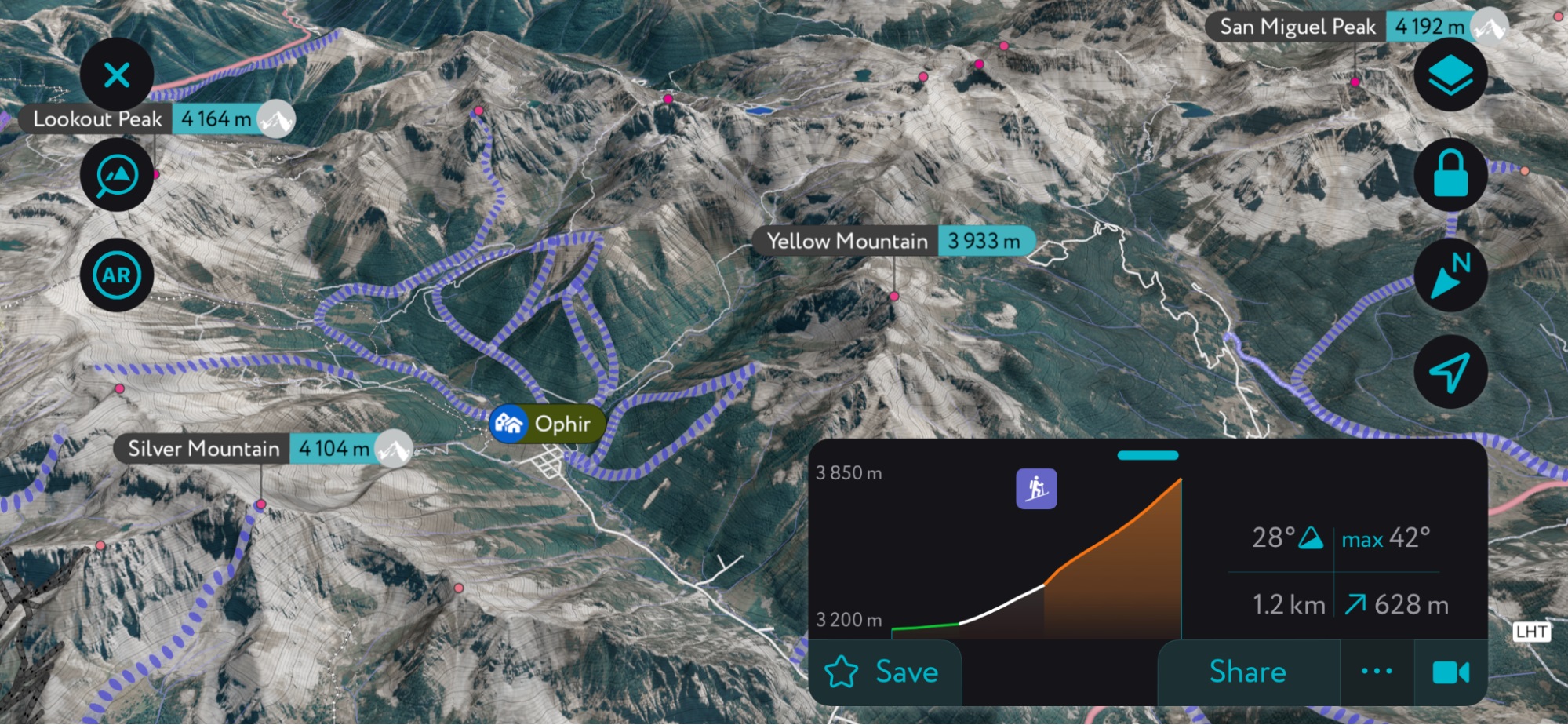
Lastly, Ophir is infamous to any skiers who follow the CAIC’s accident report due to the overwhelming number of avalanche fatalities that occur in the area, the most recent being a death on Jan. 23rd, 2024. Ophir gets a lot of snow, and the authorities occasionally bomb some slopes to protect houses and infrastructure. The snowpack usually remains sketchy throughout the winter.
Silverton is a backcountry skiing mecca unmatched in Colorado. The town sits in an ancient caldera volcano that now resembles a small, flat valley surrounded by mountains. The location is more favorable for orographic snowfall; the positioning of the mountains allows both southwest and northwest winds to deposit snow here. Therefore, Silverton gets about 30% more snowfall than Telluride.
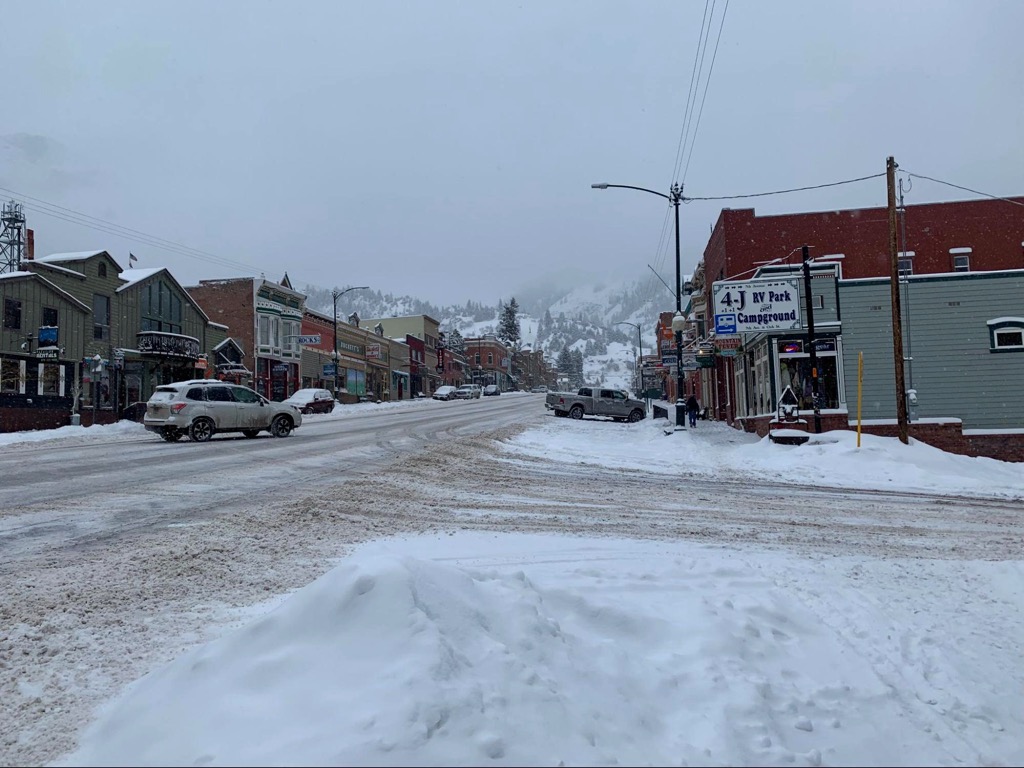
The upper Animus River runs through Silverton. Extending out of the small valley are several smaller river valleys that join with the Animus. Various forest roads - most remaining plowed in the winter - provide access to these zones.
You don’t have to venture far from Silverton to ski tour; there are incredible routes on the 13’er Kendall Mountain, and the hike starts from town. The local classic is Turkey Chute, pictured below. Turkey Chute is a long couloir descending from Hazelton Mountain. It’s been a classic for ages and was originally dubbed the “Turkey” because it was often in good condition by Thanksgiving.
I’ve uploaded some of the classic Silverton skitours onto the PeakVisor app. Check out the app for more beta!
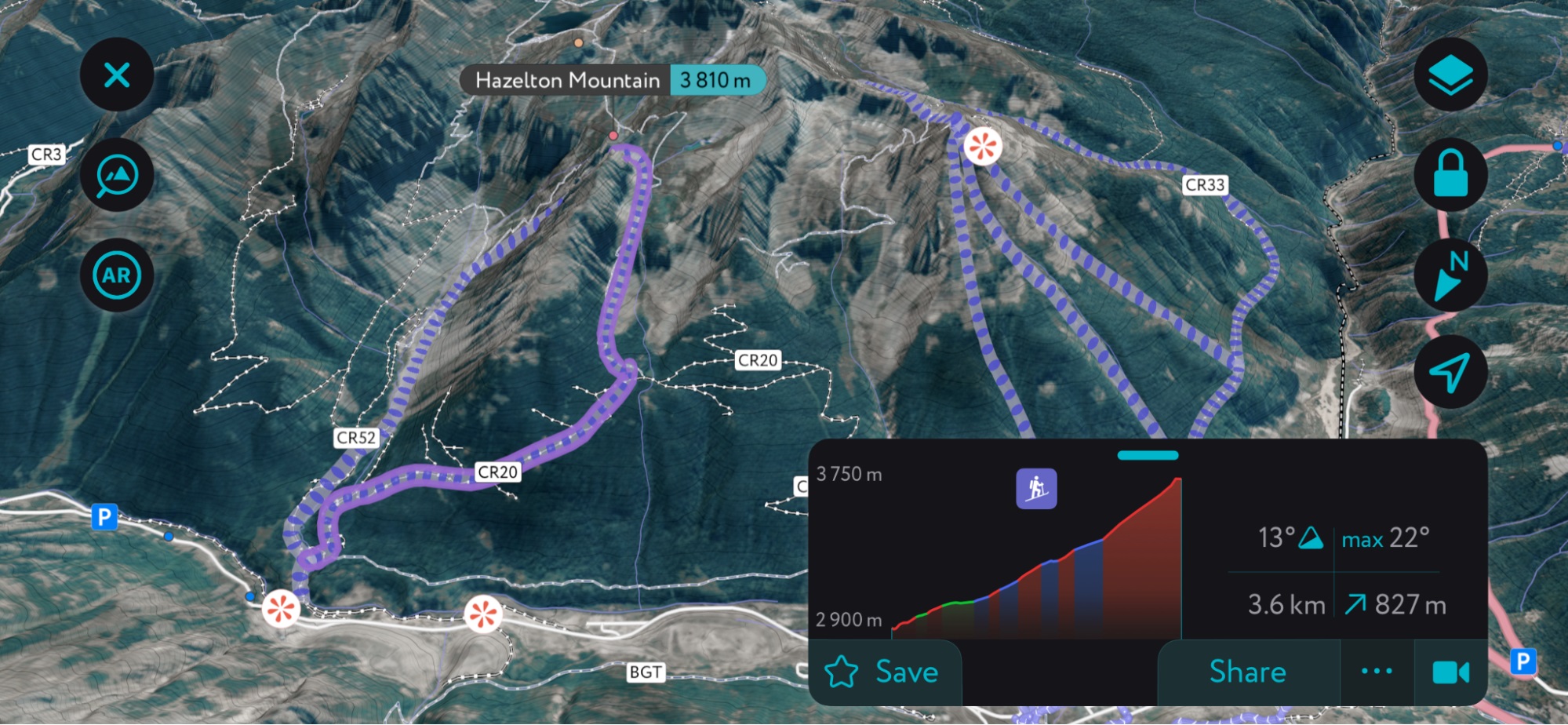
There are no two ways around it: Telluride is remarkably expensive. It’s the same profit model that Vail Resorts uses, charging an exorbitant amount for day passes and less for season passes. The only issue is that Telluride’s season pass is $2,700, unlike the Epic Pass (~$1,000). And you don’t get any additional days at other resorts.
How do locals afford it? Well, you can buy the pass before mid-November at about a $1,000 discount from the KOTO Ski Swap or the ticket office. You can also purchase it at one of several ski events throughout the U.S. during the fall. But many locals, especially those passionate about skiing, have their pass included in their work contract. The remainder qualify for a “merchant” pass at about $1,000. An early 10-day pass also rings in at about $100 per day.
For some folks reading this article, money is no object, and they’ll just buy the day tickets. You can also purchase multi-day tickets up to 10 days for a discount. Day tickets are $215 for peak season if purchased in advance online.
For everybody who wants to ski Telluride and is not a millionaire, I suggest buying an Epic Pass. I realize that this falls right into Vail Resort’s intentions - their entire price structure is designed around getting people to purchase an Epic Pass - but it really is the best option if you plan on using all seven free days at Telluride. You could ski at just Telluride, and the pass would pay for itself, but you also get 64 other resorts worldwide.
Telluride offers terrific access to groomed cross-country skiing trails along the Valley floor and the old Galloping Goose rail line just west of town. Meanwhile, there are plenty of marked snowshoe trails in the mountain village. Some of these trails are accessible via the lifts, but it’s easy to have an adventure without using the lift infrastructure. The ski resort provides excellent maps for these marked routes.
For a physical challenge, it’s also possible to snowshoe along most summer hiking trails, which lead deep into the high mountains. Naturally, you’ll have to be avalanche-aware in this terrain, similar to backcountry skiers and riders.
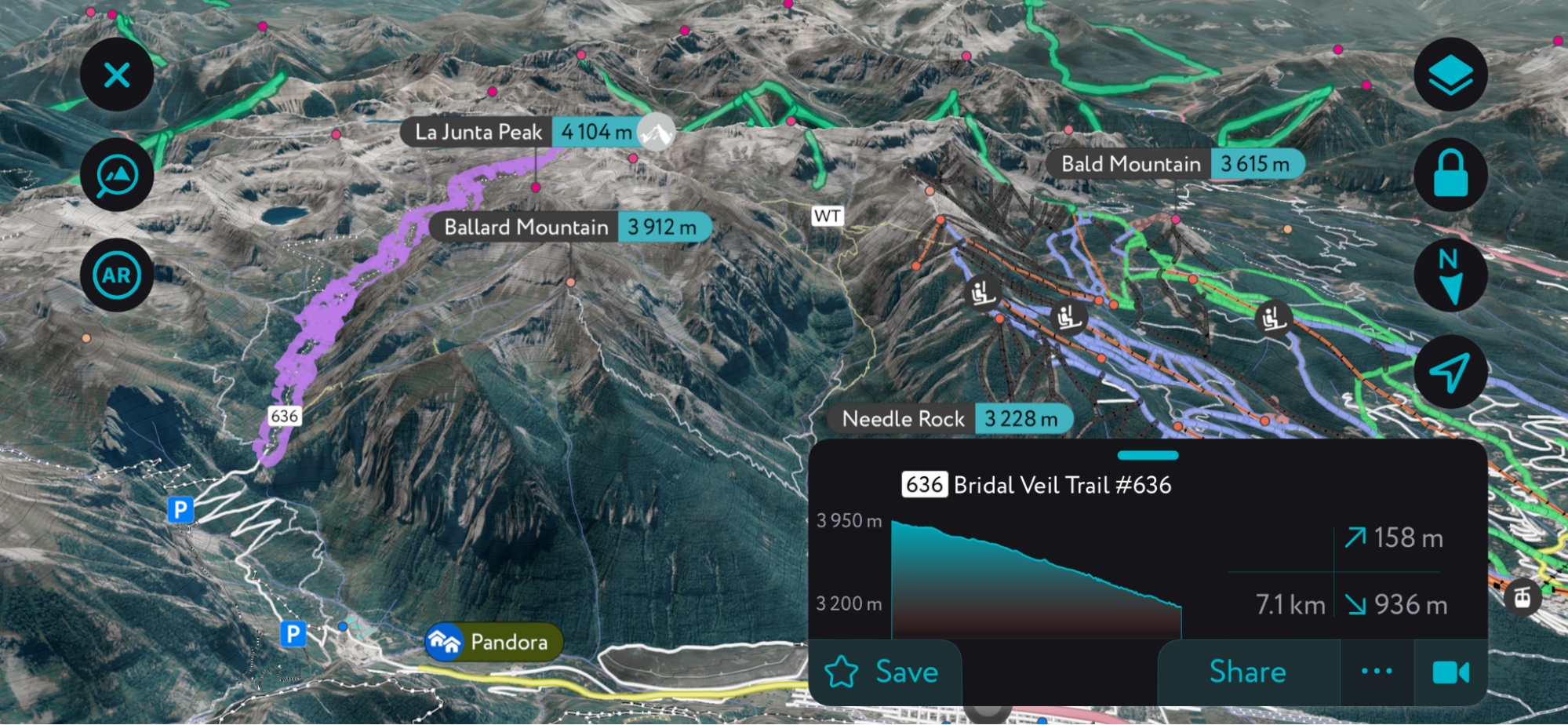
The PeakVisor mobile app is also an excellent resource for cross-country trails, like the Matterhorn trails along Route 145.
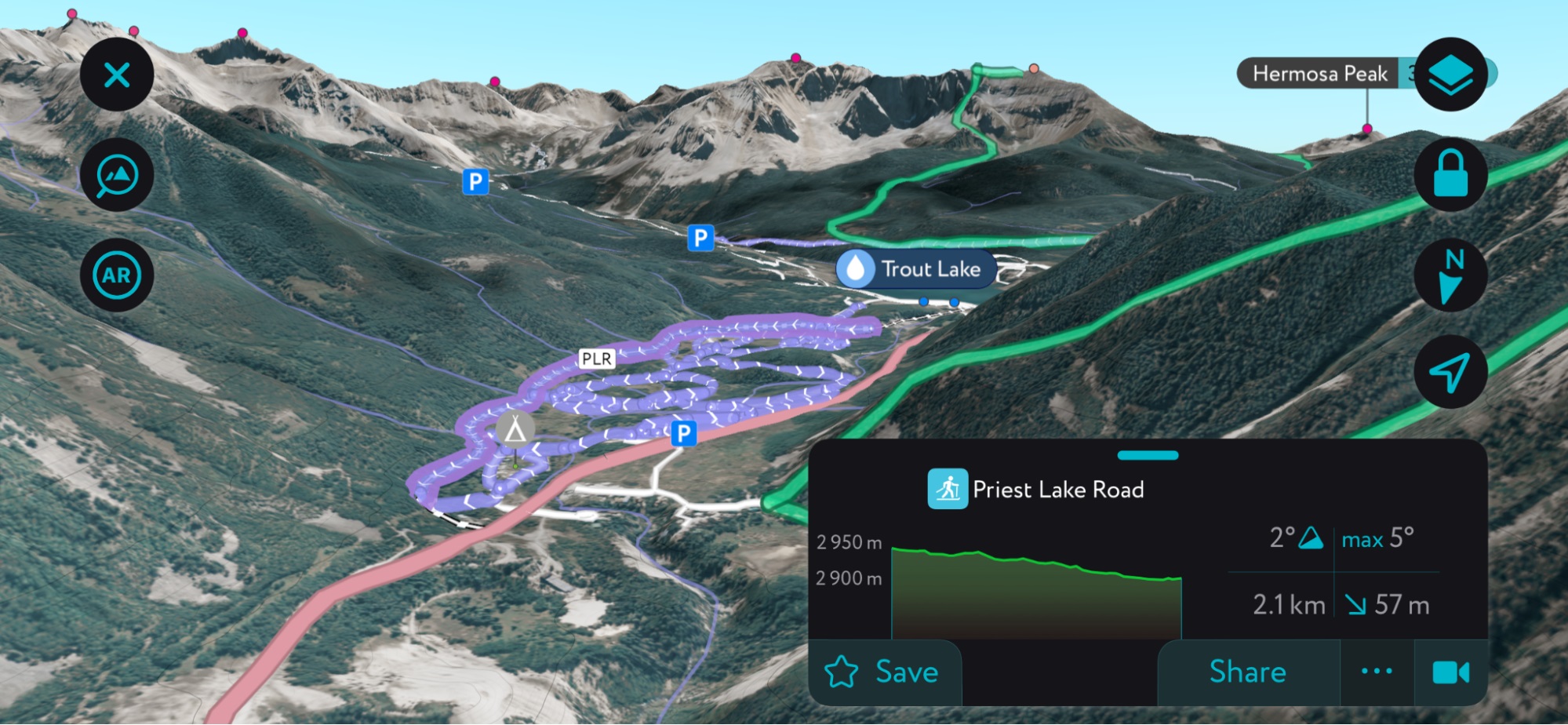
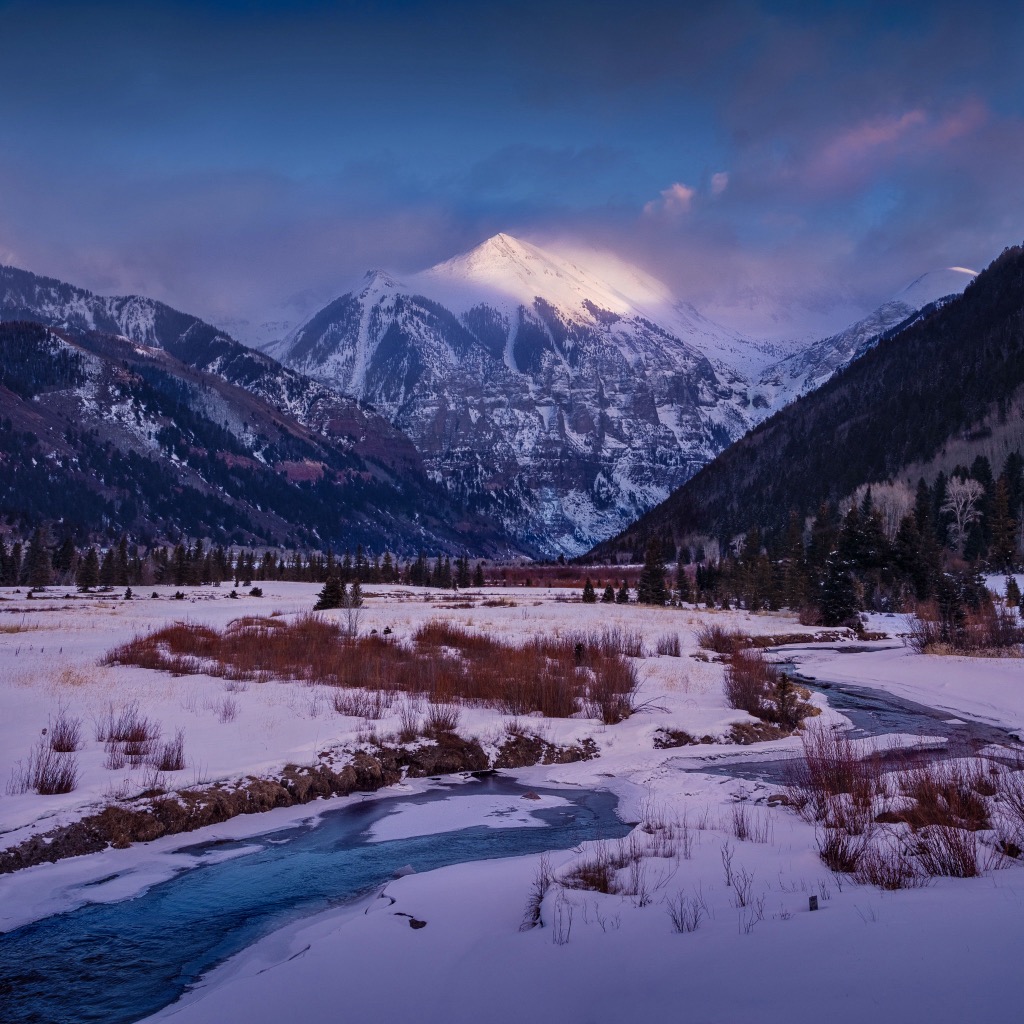
The Telluride Visitor’s Center is host to a friendly, knowledgeable crew of locals and every brochure you can possibly imagine.
Telluride Visitors Center & Tourism Board
236 W Colorado Ave.
Telluride, CO 81435
Hours: 8 a.m. to 6 p.m., daily
Website: https://www.telluride.com/plan-your-visit/visitors-center/
Telluride is host to many accommodation options; the one thing all these options have in common is their expense. The Victorian Inn, one of the cheapest stays in town, runs at $376 per night during the winter on Hotels.com. Luxurious options easily climb into the thousands per night.
The primary hotels in the town of Telluride include:
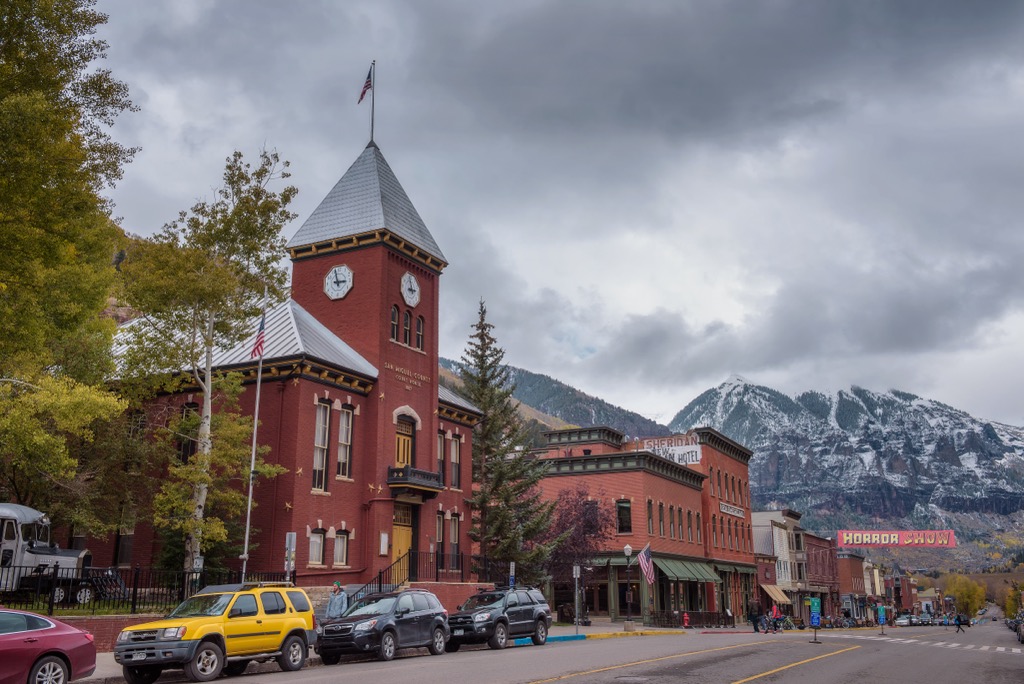
Mountain Village is bigger, newer, and more sprawling than Telluride. There’s more lodging here than in town, but it tends to be even more luxurious and expensive. Unfortunately, Mountain Village doesn’t have any of Telluride's charms. The most popular options include:
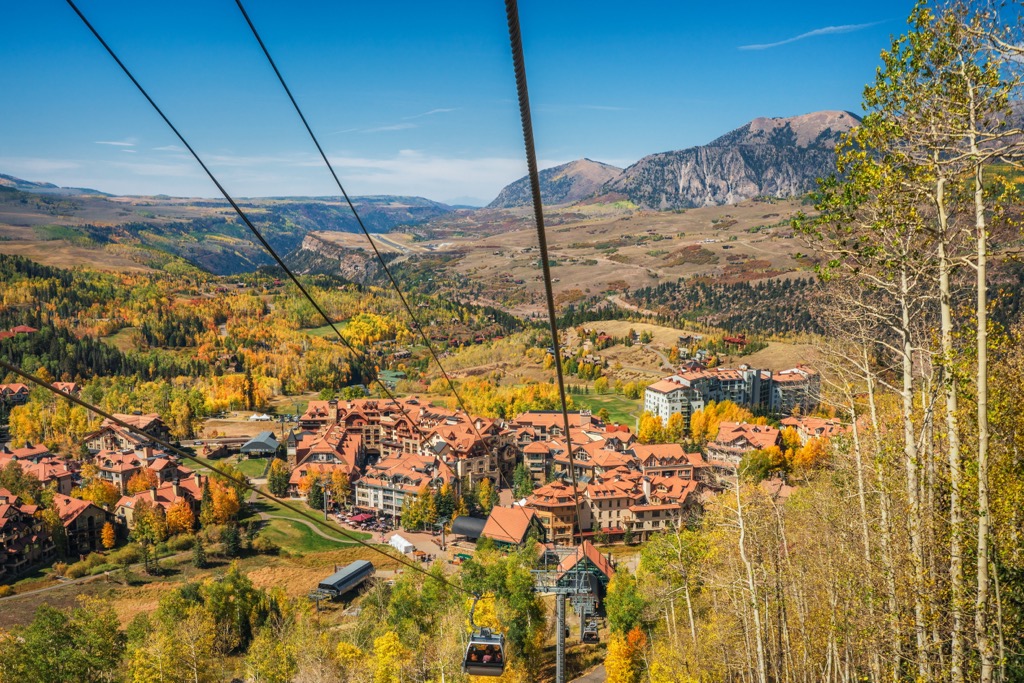
Placerville, Rico, and Ridgway are nearby towns that offer more affordable lodging for those with a vehicle. Placerville is the closest, just 20 minutes down the canyon from Telluride. Here, you can find the Bivvi Hostel, the cheapest lodging in the area. Dorm beds run at about $50 a night, while private suites are under $200. It’s only a 20-minute drive from the slopes.
Rico is a wonderfully antiquated mining town, like Telluride 50 years ago. The town has roadside hot springs, a bar called the Enterprise, and a few lodging options like the Rico Hotel. It’s about 40 minutes from Telluride, but the parking lot at Mountain Village is only 30 minutes away.
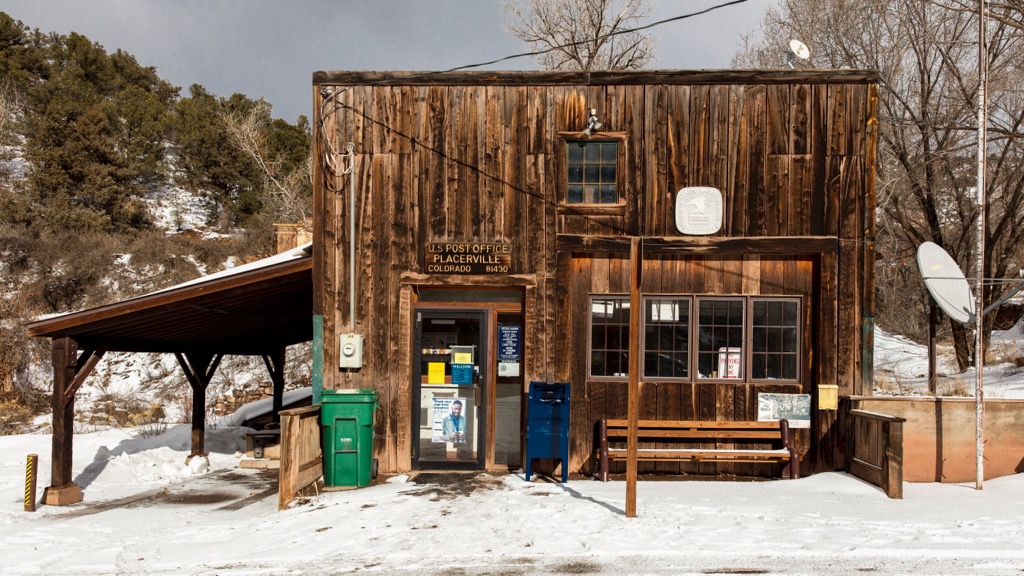
Ridgway is one of my favorite towns in the San Juans. It’s got Orvis Hot Springs, one of my favorite places in the world. The lithium water is dispersed across five or six different pools at varying temperatures, including a lobster pot that reaches about 112℉ (44.5℃). There is also a cold plunge, sauna, and a couple of private baths indoors. The whole place is clothing optional, a right that many people choose to exercise. Ridgway has a variety of good restaurants and several hotels. It’s 45 minutes from Telluride, although the drive can be painful in inclement weather.
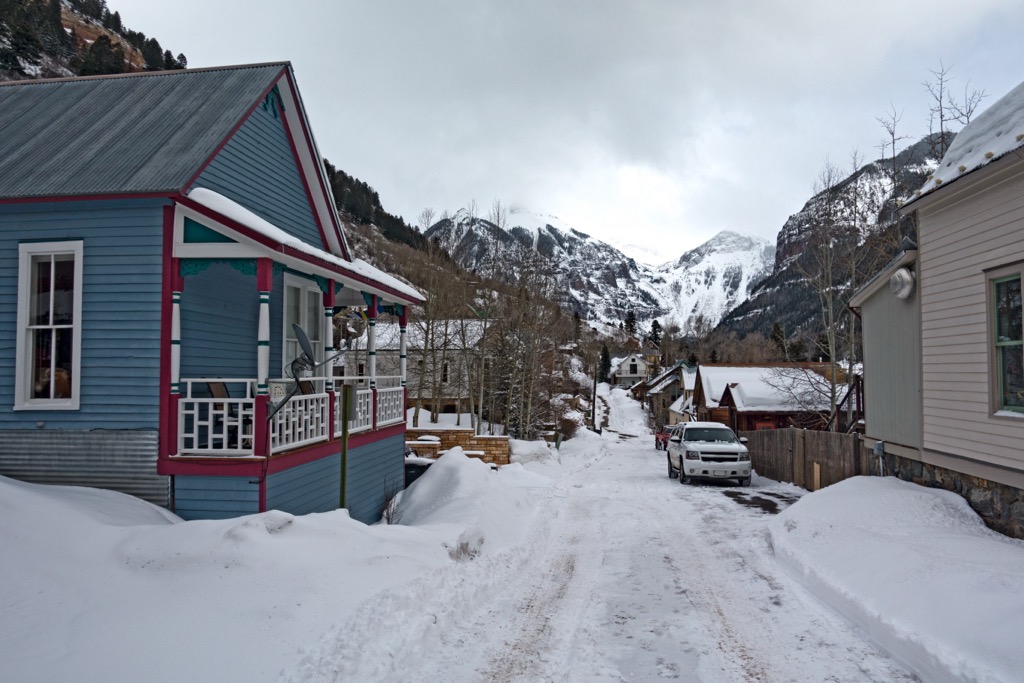
Telluride is one of my favorite places in the world. However, I don’t find the food to be exceptional. The town’s isolated perch in the mountains and the challenge of retaining good employees make providing a standout dining experience almost impossible.
Prices for everything are expensive in Telluride, and the dining experience is no exception. That said, you won’t go hungry in Telluride if you're in a spendy mood. Some of the better eateries are as follows:
Anybody who comes to Telluride and finds themselves bored has nobody to blame but themselves. The town is absolutely popping off with events as soon as the lifts close until deep into the night.
Partying is a core part of Telluride culture. For the most part, après here is pretty tame compared to European resorts like St. Anton, where rowdy dancing and binge drinking take precedence over the actual skiing. Nevertheless, it’s standard for folks to throw back a few beers after skiing; you won’t have trouble finding a place to wet your whistle.
Goronno’s, the outdoor bar under Chair 4, is the top locale for afternoon drinks and lounging. They usually have music and set up a little south-facing amphitheater with Adirondack chairs. You can’t underestimate how strong and soothing the sun is here on March afternoons. After a while, the ski patrol shuffles everybody down the mountain.
Heading down into Telluride, Oak is the spot to grab a drink and a massive portion of steak fries. Oak sits at the base of Chair 8 and the Gondola station, the hub of the Telluride ski scene. It’s particularly vivacious after big powder days in February and March.
The Stronghouse, up the street from Oak, has also become a hub for apres drinks and snacks since its inception just before the pandemic.
Despite its small size, Telluride is a hub for music. The biggest shows take place during the summer festivals, but the winter also features plenty of music. The historic Sheridan Opera House and the less-historic Club Red (Telluride Conference Center) are the main venues. Club Red may not have the charm of the Sheridan, but the sound system and acoustics are far superior.
Gay Ski Week takes place every year in late February. The week culminates with the Telluride AIDS Benefit and the “white party” at one of the bars in town.
The Nugget Theatre is a tradition for locals and tourists alike. Tickets are only $11 (they haven’t really changed in price in almost ten years), and they show a variety of major motion pictures and independent films. The theatre also holds a small place in cinematic history as one of the most desirable venues at the legendary Telluride Film Festival.
For all the latest information - and local scoop - on Telluride goings-on, check out the KOTO Community Radio (91.7 on your dial, or listen online). The station is entirely listener-supported and is one of the last of its kind in the country. Moreover, it also happens to be the best radio station in the world. You can hear the community calendar a few times a day or check out the website to just read through the upcoming events whenever you want.
Unlike the Summit County region of Colorado, where you can find dozens of ski resorts within an hour’s drive, Telluride stands alone in the San Juan Mountains. It’s a mission to get to other ski areas. Silverton Mountain, the closest “resort” to Telluride, is only ten or so miles (16 km) as the crow flies but at least a two-hour drive over gnarly mountain roads that are often closed in the winter. Purgatory and Crested Butte are about three hours away. Recently, I’ve seen more folks linking Telluride with Crested Butte because both resorts are now on the Epic Pass.
If you don’t have a Telluride season pass, the most affordable option is Vail’s Epic Pass. And if you come to Telluride on the Epic Pass, it would be a travesty not to link up at least a few days with Crested Butte. The Butte is also on the Epic, having been purchased by Vail a few years ago, and offers some of Colorado’s finest lift-access skiing.
The Butte is shaped like a Hershey’s Kiss, meaning the lower mountain is mellow and perfect for beginners, while the upper mountain is steep and gnarly, ideal for experts and powderhounds.
The town is in a Victorian style similar to Telluride, with cute, multi-colored facades and western charm. Along with Telluride, these are the most charming ski towns in the U.S.; the only shortcoming with the Butte is that you have to drive 15 minutes up to the mountain village to ski (there are plenty of buses as well).
Crested Butte was once relatively uncrowded, perhaps even more devoid of skiers than Telluride. Unfortunately for locals, that changed when Vail bought the mountain seven or eight years ago. Most days are manageable, but the lifts can get crowded on weekends and powder days because of the newfound ease of access for front-range epic pass holders.
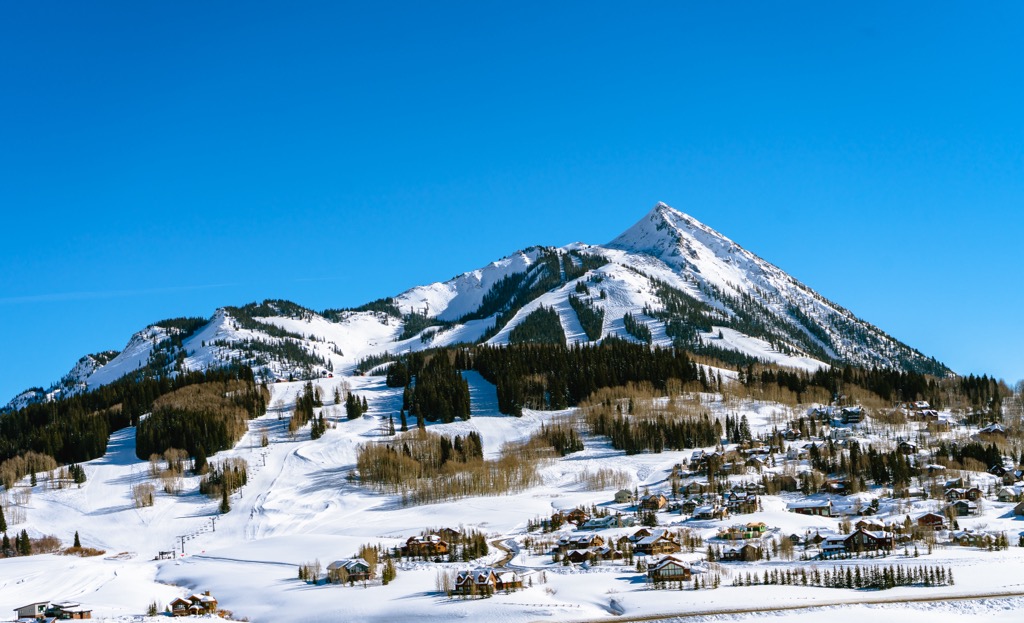
Silverton Mountain is an anomaly among lift-access ski areas in the U.S. A single, ancient two-seater chairlift services the mountain, ascending about 2000 vertical feet (600 m). An additional 1000 ft or so (300 m) is accessible via hiking along the ridge that divides the area’s east and west aspects.
There are no pistes; the skiing is an assortment of bowls, couloir, faces, and trees. The terrain is steep and exciting, and the resort markets itself as a lift-access backcountry mecca with avalanche control. Silverton has the advantage of snowfall from the north and south, which means they get about 30% more snow than Telluride. Silverton Mountain likely averages more than 350 inches (9 m) of snow per year over Telluride’s 250.
Silverton does offer an unguided pass for 25 or so unguided days in March and April. The season pass for these days was $200, but in the last couple of years, it has increased to $700 with no discernable advantage.
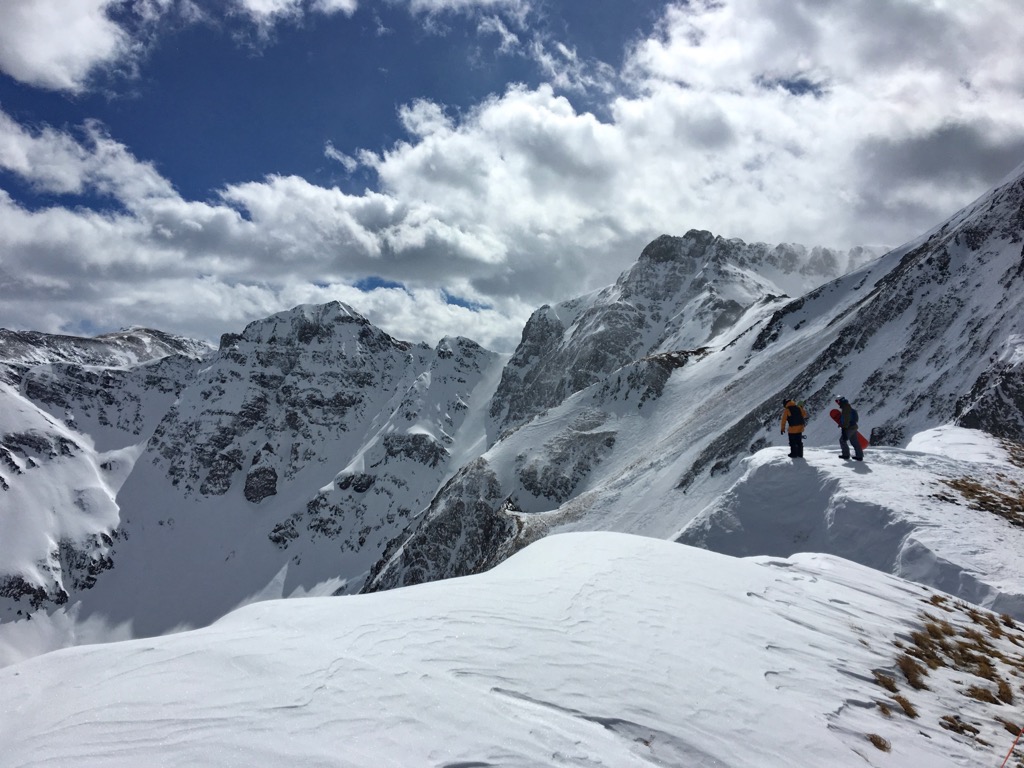
I’ve had some fun days at Silverton unguided. However, I’m not much of a fan of Silverton for several reasons:
The unguided season starts in mid-March. By this time of the year, it can be hard to get excellent conditions on the mountain because of the lack of north-facing terrain. In the dozen or so unguided days I’ve done at Silverton, I’ve had crusty conditions for about 10 of them. That’s why they offer an unguided season - it’s not worth the money clients would have to fork over for guided, and they know that.
When you get a big storm, the mountain is often shut for avalanche control, and rope drops are met with frothing hordes of powderhounds. You might snag a few soft turns between the guide tracks, the avy debris, and bomb holes.
The unguided season $40 heli drops are a complete gimmick, with the helicopter flying about 90 seconds across the valley to drop you off on a tracked-out bunny slope. It’s basically for Instagram. Even the regular heli drops, almost $200 a pop, don’t go anywhere you can’t hike to in a few hours.
Silverton once fostered a scene of backcountry enthusiasts but has slowly been widdled down into a profit machine that caters more to novices with disposable income. I guess…at least it’s not owned by Vail?
The town of Silverton and the surrounding mountains are one of the world’s true backcountry skiing meccas. My recommendation is to use the PeakVisor app and do some exploring out in the mountains, where you can find both solitude and fresh tracks. I’ve even uploaded some of the classic routes to get you started.
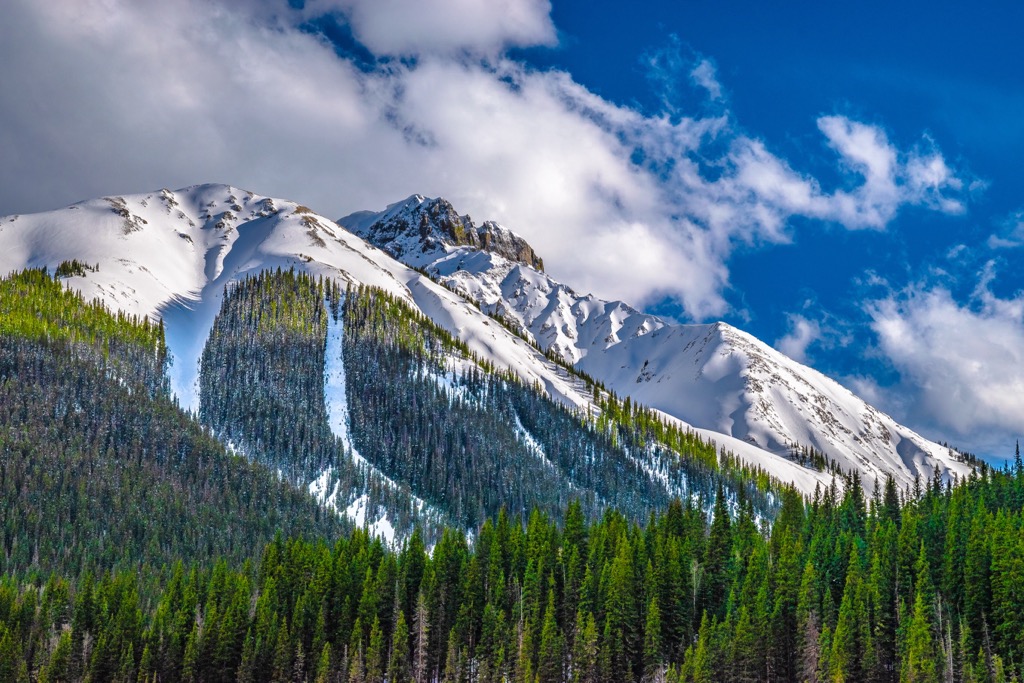
Durango is one of my favorite Colorado towns. It sits at the base of the San Juan Mountains, about a two-and-a-half-hour drive southwest of Telluride. Their local ski hill was recently rebranded Durango Mountain Resort, although everybody still calls it Purgatory.
Purg doesn’t really stack up to Telluride in terms of slopes and amenities, but it’s got a great family vibe and some fun intermediate slopes. When storms come from the south, Purgatory can sometimes snatch magnanimous amounts of snow, while Telluride gets skunked.
The town of Durango is also worth a visit during any season. Backcountry skiing in the southern San Juan Mountains is excellent, with Durango having the best access to Coal Bank and Molas Pass. Mountain biking and rafting in the summer make Durango a year-round destination.
